CO-PUBLISHED BY MEDIACORP
p The City of Vancouver recently adopted a policy that requires all new larger civic properties to be built to a minimum LEED-Gold standard.

METHODOLOGY: How this year’s winners were chosen
LIST OF WINNERS: Canada’s Greenest Employers (2023) 11
SUSTAINABLE COMMUNITY: Employers pursue a green mindset
5
12
P.J.MCFARLANE/GETTY

the search engine that brings you thousands of direct-employer jobs every day – plus exclusive employer reviews from the editors of Canada’s Greenest Employers. Each year, millions of Canadians use Eluta.ca to find hundreds of thousands of new job postings in their field.† Visit us today on your laptop or smartphone.
For the 12 months ended August 31, 2022, Eluta.ca received 2,009,405 unique visitors (desktop and mobile), who performed 12,445,027 searches. Source: Google Analytics. FIVE-STAR JOB SEARCH
search for hybrid workplace jobs on Eluta!
Discover
†
Now
CANADA’S GREENEST EMPLOYERS
2023 MAGAZINE
Anthony Meehan, PUBLISHER
Editorial Team:
Richard Yerema, EXECUTIVE EDITOR
Kristina Leung, MANAGING EDITOR
Stephanie Leung, EDITOR
Chantel Watkins, ASSISTANT EDITOR
Juliane Fung, RESEARCH EDITOR
Sonja Verpoort, RESEARCH ASSISTANT
Jing Wang, RESEARCH ASSISTANT
Advertising Team:
Ye Jin Suhe, MANAGER, PUBLISHING
Chariemagne Kuizon, JUNIOR COORDINATOR
Vishnusha Kirupananthan, BRANDING & GRAPHIC DESIGNER
Sabrina Wu, SENIOR CONTENT & PUBLISHING SPECIALIST
Sponsored Profile Writers:
Berton Woodward, SENIOR EDITOR
Abigail Cukier
Brian Bergman
Brian Bethune
Deb Bourk
Mary Dickie
Jane Doucet
Don Hauka
D’Arcy Jenish
Bruce McDougall
Rick McGinnis
Kelsey Rolfe
Diane Sims
Nora Underwood
Barbara Wickens
© 2023 Mediacorp Canada Inc. and The Globe and Mail.
All rights reserved. CANADA’S GREENEST EMPLOYERS is a trade mark of Mediacorp Canada Inc.
Editorial inquiries: ct100@mediacorp.ca
There’s been a steady stream of advocacy over the past year, much of it from the United States, decrying environmental, social and governance (ESG) standards by investment firms and pension fund managers. In states like Texas and Oklahoma, banks and other financial firms that have formal ESG guidelines are now subject to penalties and can be excluded from managing state funds.
While most Canadians might see the ‘ESG backlash’ in fossil fuel producing states as a tempest in a teapot, what’s interesting is that there isn’t a similar backlash when it comes to employers that have made environmentalism and sustainability central to their organizational culture. The reason for this is clear: people want to work for employers that care about making the planet more liveable, not less.
Over two decades ago, when we launched the Canada’s Top 100 Employers project, we noticed that a strong correlation existed between an employer’s involvement in the community and how they treat their own employees. Organizations that took a broader view of their responsibilities to the community, it turned out, were almost always better places to work.
Today marks the 16th edition of our Canada’s Greenest Employers competition, which recognizes the employers that lead the nation in creating a culture of environmental
liveable.
awareness. These employers have developed interesting sustainability initiatives – and are attracting people to their organizations because of their environmental leadership.

Again this year, our editors have brought you stories on employers from every part of Canada in a wide range of industries that are making a difference. This year’s announcement magazine is chock-full of stories of how this year’s winners are moving the dial, in large ways and small, toward making their operations sustainable. Starting this morning, you can also read our editors’ full reasons for selection explaining why each of the winners was chosen: www.canadastop100.com/green
For job-seekers, there’s never been a better time to find an employer that shares your interest in sustainability and protecting our common environment. In today’s tight job market – with unemployment near all-time lows – jobseekers have more options than ever and they are choosing employers that are stewards of the environment.
From our modest editorial perch, we’ll continue to shine a light on the practical initiatives these employers are doing to make their operations sustainable. Our hope is that other employers in Canada take note and adopt these best practices, raising the bar and making us responsible stewards for the next generation.
Tony Meehan
3 CANADA’S GREENEST EMPLOYERS (202 3) PROVIDED CONTENT
–
p Job seekers and employees want to work for employers that care about making the planet more
A.NAKIC/GETTY
Introduction
In a recent video introducing the United Nations’ flagship Climate Report, UN Secretary-General António Guterres referenced the title of this year’s absurdist Oscarwinning film as he called for urgent climate action “on all fronts – everything, everywhere, all at once.” It’s a caveat Canada’s Greenest Employers 2023, selected by Mediacorp Canada Inc., take to heart; it’s also an apt description of their efforts on multiple fronts, big and small, to embrace sustainability.
All have made the environment a priority in how they run their business,
with ambitious targets aimed at reducing their organization’s own carbon footprint.
That includes formalized sustainability strategies to identify areas within their operations where they can improve, along with exceptional sustainability programs and initiatives.

The winners offer a myriad of practical initiatives, ranging from onsite honeybee apiaries to recycling and landfill diversion to the greening of vehicle fleets. Other popular programs include tree planting and community gardens as well as some innovative twists. ENMAX, an electricity provider
weeds at its Cavalier Energy Centre facility as an environmentally friendly alternative to traditional herbicides. The bonus is that it aerates, mulches and fertilizes the soil naturally.
Environmental leadership also includes promoting a culture of awareness that engages employees and encourages individuals to make responsible choices both in the workplace and at home. Many employers offer green commuting options such as transit passes, secure bicycle parking and preferential parking for carpoolers and employees driving hybrid or electric cars. Medtronic Canada, a
Brampton, Ont.-based manufacturer of medical devices, additionally provides two hours of free charge time at its onsite EV charging stations. Nice perk!
Sustainability also make sense from a business perspective. Job seekers and employees want to work for an employer that cares about making our planet more liveable, and where corporate values align with their own. Likewise, an organization’s sustainability is important to concerned customers who are increasingly aware of a company’s environmental policies. More than ever, every choice matters.
– Diane Jermyn
4 CANADA’S GREENEST EMPLOYERS (202 3) PROVIDED CONTENT
in Calgary, uses goats to manage
p UNBC finances a Green Fund for various sustainability projects across the campus as well as the Energy Conservation Revolving Loan Fund to support energy-efficient projects (uses energy cost savings to repay the loans).
UNBC
ABB CANADA, Saint-Laurent, Que. Engineering and technology; 2,971 employees. Sponsors small and big environmental initiatives, from installing two bee apiaries at its Montreal campus to extensive in-house waste reduction and recycling programs.
ACCENTURE INC., Toronto. Professional services; 5,682 employees. Set ambitious zero-waste goals with the aim to reuse or recycle 100 per cent of e-waste and office furniture by 2025.
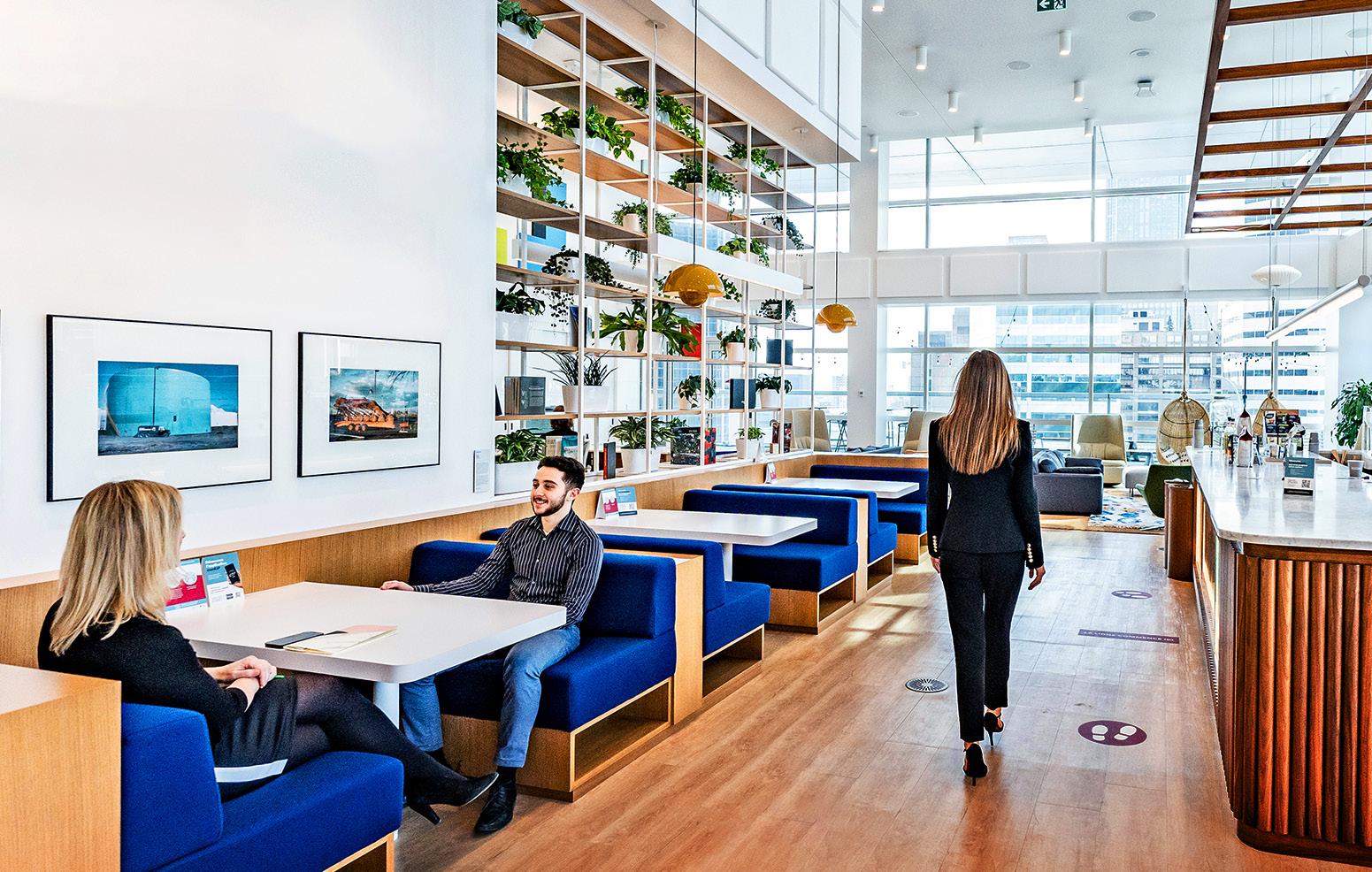
AET GROUP INC., Kitchener, Ont. Environmental consulting; 31 employees. Manages an in-house sustainable
2023 WINNERS
transportation program that features an online tracker of commuting habits and a formal telecommuting policy.
ARAMARK CANADA LTD., Mississauga. Food service contractors; 6,535 employees. Manages the Food Management Fundamentals Program that is designed to help the company prevent food waste before it is created.
ASSINIBOINE CREDIT UNION LTD., Winnipeg. Credit union; 452 employees. Encourages employees to reduce their carbon footprint with subsidized bus passes, support for a carpool matching service and showers and lockers at new branches.
BC HOUSING MANAGEMENT COMMISSION, Burnaby, B.C. Provincial government; 952 employees. Manages the unique People, Plants and Homes Program that offers therapeutic horticulture programming year-round to hundreds of residents throughout the province.
BC HYDRO, Vancouver. Hydroelectric power generation; 6,533 employees. Operates a unique Bike Buddy Network to help connect employees who regularly bike to work and provide resources for those new to bicycle commuting.
BC PUBLIC SERVICE, Victoria. Provincial government; 33,041 employees. Encourages
employees to get involved in the service’s numerous initiatives with Green Teams at locations across the province.
BELL CANADA, Verdun, Que. Communications; 34,983 employees. Donates the residual value of returned and recycled mobile devices to World Wildlife Fund Canada’s ambitious decade-long Regenerate Canada program.
BLACKBERRY LTD., Waterloo, Ont. Secure software and services; 1,720 employees. Has a longstanding in-house program to identify restricted substances for all parts, components, assemblies and materials used in the manufacture of its products.
5 CANADA’S GREENEST EMPLOYERS (202 3) PROVIDED CONTENT
p Ivanhoé Cambridge, a real estate firm based in Montreal, conducts annual waste audits at all of its property locations, with waste diversion rates increasing from 43 per cent in 2010 to 61 per cent in 2019.
2023
IVANHOE CAMBRIDGE
2023 WINNERS Continued
BLUEARTH RENEWABLES INC., Calgary. Renewable power generation; 114 employees. Completed construction of a new passageway to allow for the safe movement of a variety of animal species across a busy roadway.
BOSTON CONSULTING GROUP
CANADA ULC, Toronto. Management consulting; 475 employees. Supports employee green teams in its offices around the world with more than 1,300 employee volunteers in over 80 offices worldwide.
CADILLAC FAIRVIEW CORP. LTD., Toronto. Real estate management; 1,254 employees. Supports 24 rooftop beehives at 12 property locations that are home to more than 350,000 honeybees.
CANON CANADA INC., Brampton, Ont. Imaging equipment and information services; 794 employees. Features numerous impactful environmental features at its head office, including drought-resistant plantings to reduce water demand and light sensors to adapt to daily use patterns.
CANOPY PLANET SOCIETY, Vancouver. Environmental consulting; 19 employees. Is committed to purchasing second-hand office furniture, office supplies and equipment where possible and to continuously reduce paper usage through electronic communications.

CAPITAL REGIONAL DISTRICT, THE / CRD, Victoria. Municipal government; 735 employees. Has an ongoing zero-emissions fleet initiative that includes adopting and testing e-bikes, electric vehicles and hydrogen fuel cell vehicles.
CIBC, Toronto. Banking; 40,048 employees. Committed to source 100 per cent of electricity from renewable sources and to becoming carbon neutral by 2024.
CO-OPERATORS GROUP LTD., The, Guelph, Ont. Insurance; 6,797 employees. Encourages its customers to make greener choices, including insurance discounts for LEED construction and automobile insurance discounts for hybrid and electric vehicles.
CREDIT VALLEY CONSERVATION
AUTHORITY / CVC, Mississauga. Environment, conservation and wildlife organizations; 235 employees. Has a LEED Gold-certified head office that includes LED motion-controlled lighting, in-floor
radiant heating, recyclable carpeting and new smart blue roof technology.
DENTONS CANADA LLP, Edmonton. Law firm; 1,357 employees. Introduced a number of dedicated plastic use reduction and elimination efforts, including stopping the use of plastic straws and single-use plastic cutlery.
DESJARDINS GROUP / MOUVEMENT
DESJARDINS, Lévis. Que. Financial institution; 48,129 employees. Offset 100 per cent of its 2020 greenhouse gas emissions through purchase of carbon credits and working in partnership with a variety of organizations.
DIAMOND SCHMITT ARCHITECTS INC., Toronto. Architecture; 268 employees. Encourages employees to put into practice some of their green knowledge through volunteering in new home construction with Habitat for Humanity.
DURHAM COLLEGE OF APPLIED ARTS AND TECHNOLOGY, Oshawa, Ont. College; 785 employees. Encourages employees and students to choose sustainable methods of transportation through partnership with SustainMobility’s Commute Ontario program.
EFFICIENCYONE, Dartmouth, N.S. Energy conservation advocacy; 159 employees. Manages all recyclable, compostable and waste materials in accordance with municipal as well as LEED standards for existing buildings.
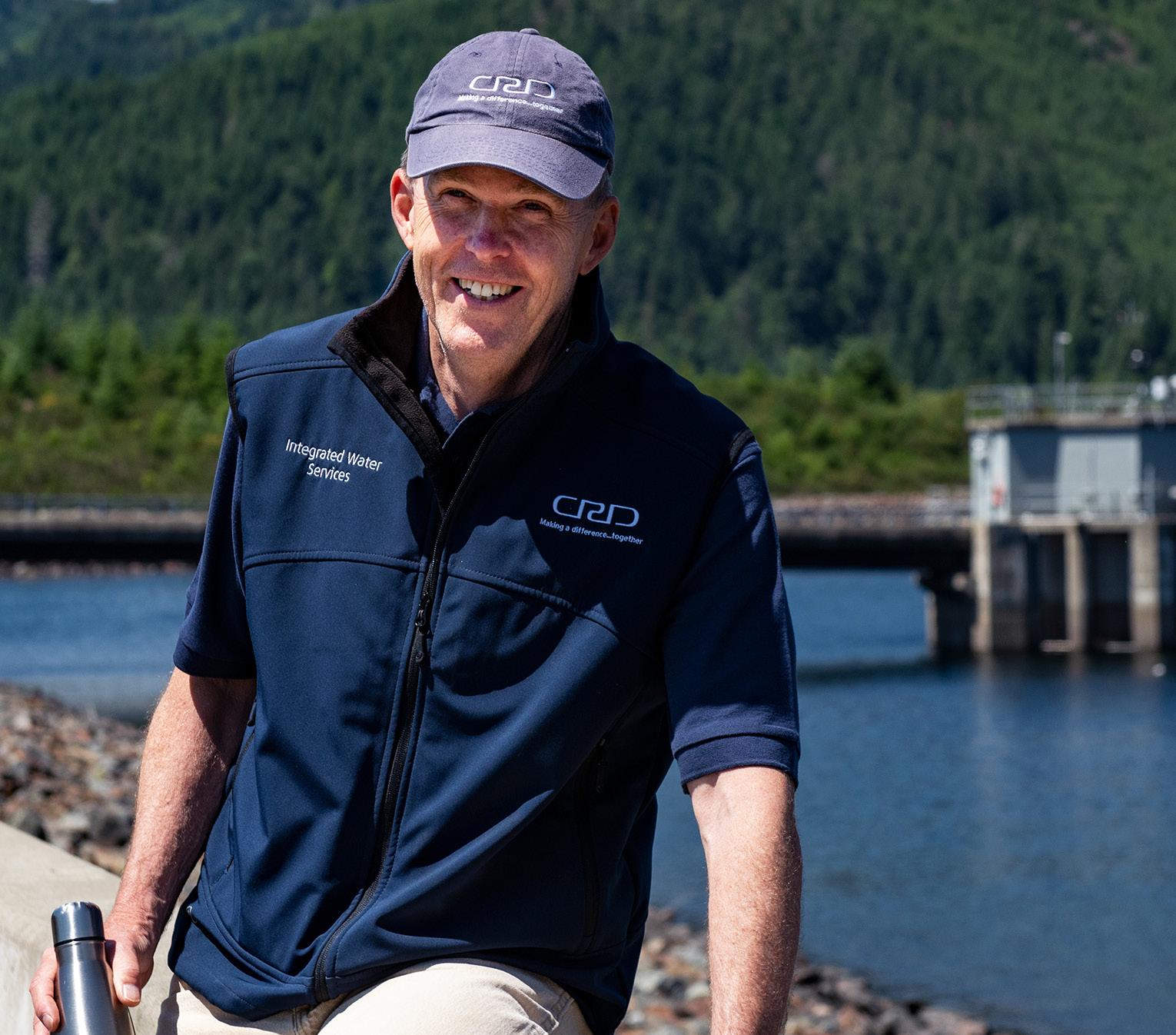
EMTERRA GROUP, Oakville, Ont. Recycling and waste management; 788 employees. Partners with local organizations to heighten awareness and increase access to resources for waste reduction.
ENMAX CORP., Calgary. Electric power distribution; 1,549 employees. Uses the services of Goats for Weeds to help reduce the use of traditional herbicides in its weed management program on its Cavalier Energy Centre facility property.
EVOLUGEN, Gatineau, Que. Renewable energy generation and services; 238 employees. Features an emphasis on environmental initiatives in its community and charitable program, including supporting initiatives across the country.
EXPORT DEVELOPMENT CANADA, Ottawa. International trade financing and
6 CANADA’S GREENEST EMPLOYERS (202 3) PROVIDED CONTENT
p Canopy Planet Society founder Nicole Rycroft (left) and board member Farwiza Farhan in Indonesia, working to protect the world’s forests.
CANOPY CRD
p Capital Regional District hosts educational programs, including tours of the Sooke Lake Reservoir, the main water supply in Victoria.
2023 WINNERS Continued
support; 2,019 employees. Partnered with Alvéole to introduce two rooftop beehives that are home to 50,000 bees.
FARM MUTUAL REINSURANCE PLAN INC. / FARM MUTUAL RE, Cambridge, Ont. Insurance; 83 employees. Encourages green habits every day with recycling bins located at employee desks along with onsite collection of organics, e-waste, batteries and eyeglasses.
FLEMING COLLEGE, Peterborough. College; 547 employees. Continues to build upon its unique environmental educational programming through a commitment to increase the number of sustainably focused courses by 50 per cent.
FORTISALBERTA INC., Calgary. Electric power distribution; 1,108 employees. Has developed a number of formal initiatives to mitigate its impact on local wildlife, including the Woodland Caribou protection program.
GEOTAB INC., Oakville, Ont. Fleet management software; 1,437 employees. Features regular sustainability activities to engage employees and create greater awareness in a fun way, hosted by its employee-led Go Green Team.

G&W CANADA CORP., Brampton, Ont. Switchgear manufacturing; 173 employees. Has steadily increased its waste from landfill diversion rates (to 86 per cent) and contracted a third-party environmental consultancy to conduct independent audits.

HATCH LTD., Mississauga. Engineering; 3,653 employees. Encourages its suppliers and service contractors to offer environmentally preferred products and services, as part of its formal environmental procurement policy.
HOME DEPOT CANADA, Toronto. Retail; 36,497 employees. Has 49 stores with rooftop solar panel arrays, three LEED-certified store locations, and many green features incorporated into its new constructions.
HP CANADA CO., Mississauga. Computer technology and services; 683 employees. Incorporates environmental considerations into all product design, from the longstanding Planet Partners consumer return and recycling program to its en-
vironmental packaging strategy program.
HUMBER COLLEGE, Toronto. College; 1,826 employees. Actively extends its sustainability perspective to its surrounding communities, hosting various environmental and outdoor education programs and events for the public.
HYDRO OTTAWA, Gloucester, Ont. Electric power distribution; 687 employees. Has partnered with the City of Ottawa to install solar panels on eight municipal buildings.
ICBC
/ INSURANCE
CORPORATION OF BRITISH COLUMBIA, North Vancouver. Automobile insurance; 5,875 employees. Supports an employee-led Green Team with more than 115 members at locations across the province.
ICE RIVER SUSTAINABLE SOLUTIONS, Shelburne, Ont. Bottled water manufacturing; 468 employees. Introduced a unique “Keep a Lid on It” education program to encourage people to leave the lids on their recycled plastic bottles to ensure they are captured.
IKEA CANADA LTD. Partnership, Burlington, Ont. Retail; 3,826 employees. Ensures employees become advocates for its many environmental practices, offering all store employees regular sustainability training and reviews every three years.
IVANHOÉ CAMBRIDGE INC., Montreal. Real estate investment and management; 528 employees. Has set LEED Gold certification standard as the minimum target for all new office building constructions and over half of its office building portfolio are LEED-certified.
KEILHAUER LTD., Toronto. Furniture manufacturing; 235 employees. Developed a new website for its customers featuring a sustainability score card listing all of the company’s products along with their specific environmental attributes. KPMG LLP, Toronto. Accounting; 9,926 employees. Has numerous programs to reduce waste and enhance recycling programs at offices across the country, achieving a waste diversion rate of over 97 per cent at the downtown head office.
LABATT BREWERIES OF CANADA, Toronto. Breweries; 3,681 employees. Introduced a new fastener solution made of recyclable fibre paperboard to replace the
7 CANADA’S GREENEST EMPLOYERS (202 3) PROVIDED CONTENT
p Emterra Group, based in Oakville, Ont., partners with local organizations to heighten awareness and increase access to resources for waste reduction.
p Toronto-based furniture maker Keilhauer operates a Take-Back program that allows customers to return some used furniture for disassembly and recycling.
EMTERRA
KEILHAUER
2023 WINNERS
Continued use of plastic rings, tops and shrink film.
LOBLAW COMPANIES LTD., Brampton, Ont. Supermarkets and grocery stores; 31,708 employees. Established an internal plastic steering committee to review plastic use across its entire business.
LOYALTYONE, CO., Toronto. Marketing consulting; 816 employees. Encourages employees to consider alternate transportation with transit subsidies, discounts on car-sharing services and corporate memberships for bike-sharing services.

MANITOBA HYDRO, Winnipeg. Hydroelectric power generation; 4,764 employees. Maintains numerous community partnerships to address not only the impacts of its own operations but also environmental issues across the province.
MATRIX SOLUTIONS INC., Calgary. Environmental consulting services; 474 employees. Has two certified environmental auditors plus additional EMS practitioner employees who help to oversee the formal environmental management system manual, which is reviewed and updated regularly.
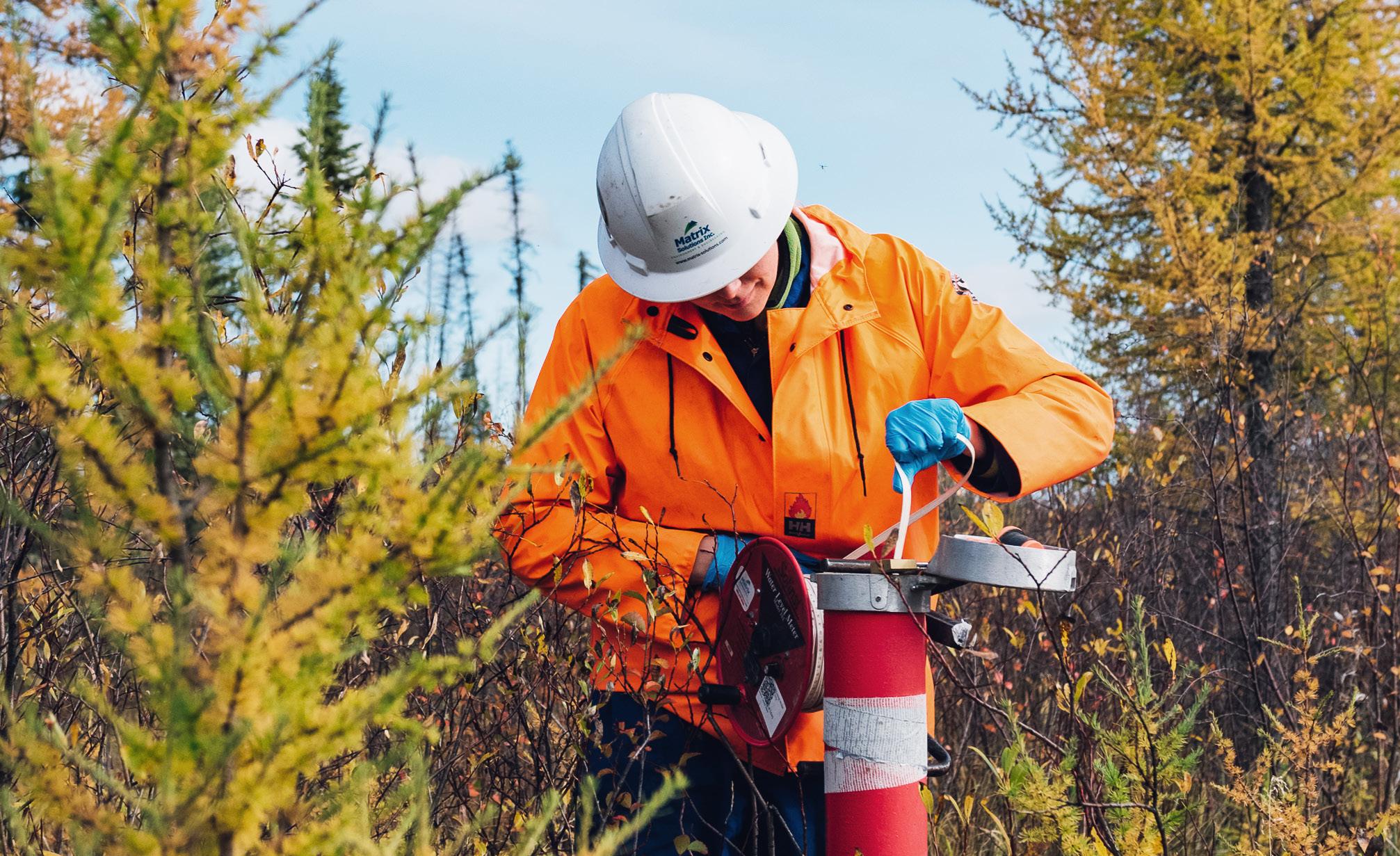
MEC MOUNTAIN EQUIPMENT COMPANY LTD., Vancouver. Retail; 693 employees. Has eliminated tonnes of plastic waste since 2010 by introducing the use of a ‘sushi-roll’ packaging technique for its MEC-branded gear.
MEDTRONIC CANADA ULC, Brampton, Ont. Electromedical apparatus manufacturing; 701 employees. Is a founding member of the Canadian Coalition for Green Health Care that promotes environmentally responsible practices in the delivery of health care services.
METROLINX, Toronto. Public transit; 4,622 employees. Is part of the largest rapid transit expansion program in North America that includes $75-billion in new capital projects.
MOHAWK COLLEGE, Hamilton. College; 1,050 employees. Has introduced numerous environmental programs across the campus, including community gardens, honeybee apiaries, pollinator gardens and water bottle filling stations.
MOTT MACDONALD CANADA LTD., Vancouver. Engineering; 240 employees. Manages a unique in-house carbon portal
8 CANADA’S GREENEST EMPLOYERS (202 3) PROVIDED CONTENT
p Toronto-based LoyaltyOne is located in a LEED Platinum-certified building and its recycling program captures everything from old pens, organics to e-waste.
T.ALDERSLEY/MATRIX LOYALTYONE
p A hydrogeologist at Calgary-based Matrix Solutions takes groundwater samples to test water quality.
2023 WINNERS
Continued
assessment tool that is designed to measure and reduce carbon and costs for the firm’s projects.
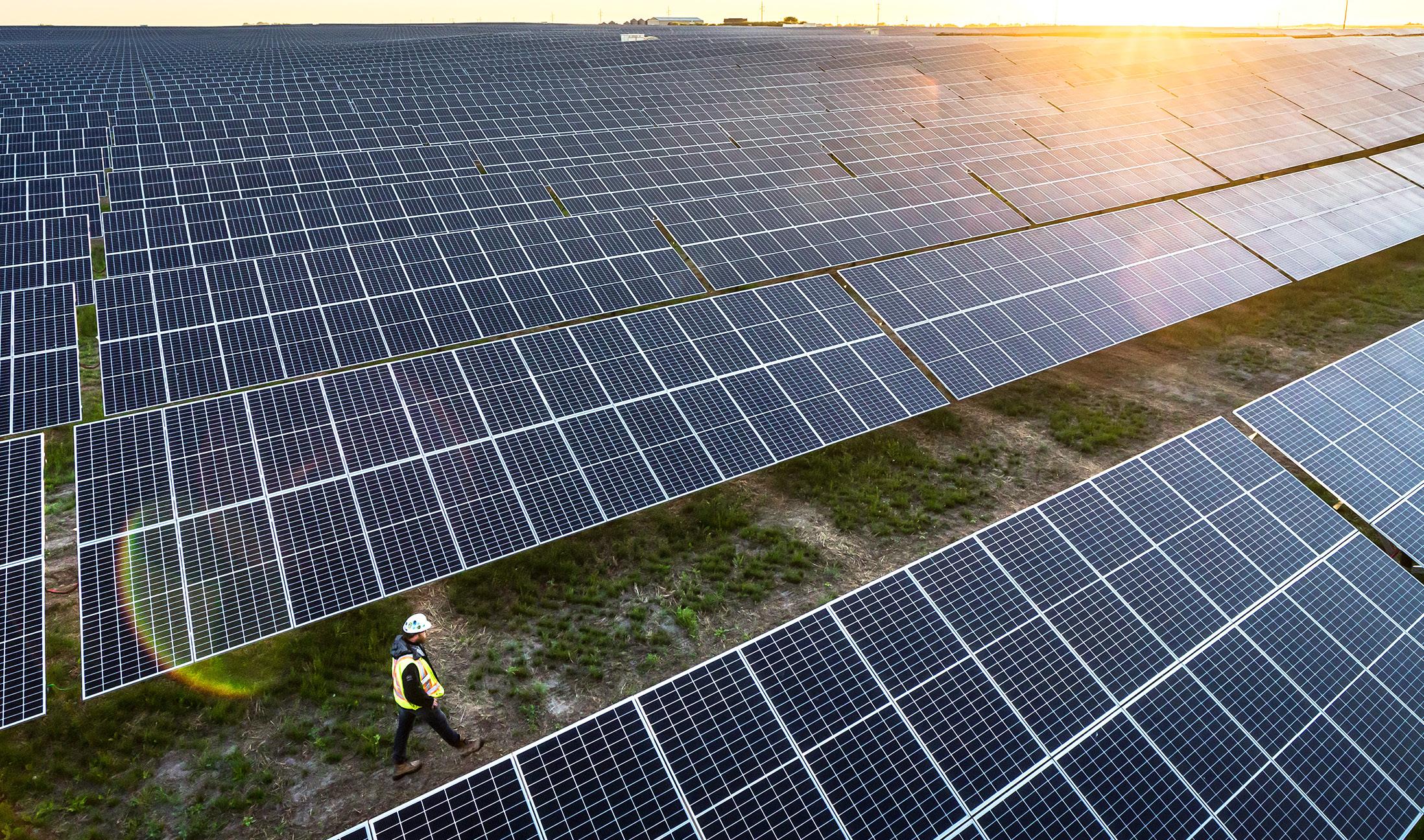
NATURE’S PATH FOODS, INC., Richmond, B.C. Food manufacturing; 247 employees. Donates 1 per cent of sales from its “EnviroKidz 1% for the Planet” line to environmental charities supporting habitat restoration, endangered species conservation and environmental education for youth.
NIGHTINGALE CORP., Mississauga. Furniture manufacturing; 113 employees. Continues to exceed minimum industry standard, ensuring all of its chairs are Greenguard-certified as low-emitting products.
PACIFIC BLUE CROSS, Burnaby, B.C. Insurance; 749 employees. Has made significant efforts in reducing its paper consumption by moving to online communications where possible and even encouraging employees working from home to reduce their paper use.
PCL CONSTRUCTION, Edmonton. Industrial, commercial and institutional building construction; 2,697 employees. Manages a dedicated network of sustainable construction advisors to provide in-house expertise on sustainable construction practices and in-office sustainability initiatives.
PERKINS&WILL CANADA ARCHITECTS
CO., Vancouver. Architecture; 221 employees. Is a signatory to the 2030 Challenge, to challenge industry professionals to make all projects carbon neutral by 2030.

RONA, Boucherville, Que. Retail; 13,572 employees. Has extensive waste management programs at all of its store locations, capturing a wide range of store and customer waste.
RTS CANADA, Richmond, B.C. Waste management and recycling; 85 employees. Has replaced sending gifts to clients with planting trees on their customers’ behalf in partnership with Tree Canada.
SAP CANADA INC., Vancouver. Custom computer programming services; 3,325 employees. Has impressively reduced its overall paper consumption by over 88 per cent over a baseline year of 2009.
SASKPOWER, Regina. Electric power
9 CANADA’S GREENEST EMPLOYERS (202 3) PROVIDED CONTENT
p MEC Mountain Equipment Company has eliminated tonnes of plastic waste since 2010 by introducing the use of a ‘sushiroll’ packaging technique for its MEC-branded gear.
p PCL employees can volunteer to join the company’s Solar Centre of Excellence for opportunities to work on some of Canada’s largest solar facilities.
M. KOOTNIKOFF/MEC
W.
SKUPINSKI/PCL
2023 WINNERS
Continued generation; 3,298 employees. Donates used (but functional) phones to SaskTel’s Phones for Fresh Start recycling program that provides refurbished phones and accessories to people in need.
SASKTEL, Regina. Telecommunications; 2,659 employees. Has a longstanding partnership with Computers for Schools that works to refurbish and donate computers to schools across the province.
SHERIDAN NURSERIES LTD., Georgetown, Ont. Nursery and garden centre; 212 employees. Developed and manages a massive water recapture pond to collect rainwater and water runoff from its operations to significantly reduce its water draw from local sources.
SIEMENS CANADA LTD., Oakville, Ont. Engineering; 2,260 employees. Features a number of energy-saving initiatives at its head office, including LED lighting systems, building automation controls and lighting sensors where possible.
SLEEMAN BREWERIES LTD., Guelph, Ont. Breweries; 1,065 employees. Maintains a formal Environmental SteeringCommitteethatisresponsibleforoverseeing various initiatives such as procurement policies and waste diversion programs.
SODEXO CANADA LTD., Montreal. Food service contractors; 8,858 employees. Has a formal plastics reduction policy to eliminate the use of plastic straws, stir sticks, plastic bags, takeout containers and polystyrene containers from its operations.
SUNNYBROOK HEALTH SCIENCES
CENTRE, Toronto. Hospital; 6,780 employees. Encourages employees to consider cycling through the employee-led Bikes User Group Sunnybrook, secure bike parking and hosting several bike-share stations.

SURREY, CITY OF, Surrey, B.C. Municipal government; 2,106 employees. Manages a unique organic biofuel processing facility to process collected organics, with the renewable natural gas being used to help power its fleet of garbage collection trucks.
SURREY SCHOOL DISTRICT NO. 36, Surrey, B.C. Schools; 10,194 employees. Champions a number of energy-producing features, including solar walls to preheat outdoor air at four locations and LED lighting upgrades at all locations.

SYMCOR INC., Mississauga. Data
processing and support services; 1,193 employees. Supports various in-house environmental initiatives that includes an extensive recycling program offered in partnership with TerraCycle and Cascades Recovery+ to capture non-conventional recyclables.
TD BANK GROUP, Toronto. Banking; 59,100 employees. Has provided over $105-million to over 28,500 local environmental projects since 1990 through its longstanding TD Friends of the Environment Foundation.
TELUS COMMUNICATIONS INC., Vancouver. Telecommunications; 25,474 employees. Has a longstanding partnership with Tree Canada to offset its paper usage through tree-planting, having planted (and helped maintain) more than 750,000 trees across Canada.
TORONTO ZOO, Toronto. Zoos and botanical gardens; 273 employees. Has partnered with Pollution Probe to focus on plastic pollution reduction in the local watershed as part of the Great Lakes Plastic Cleanup Program.
TOYOTA MOTOR MANUFACTURING
CANADA INC. / TMMC, Cambridge, Ont. Automobile manufacturing; 10,009 employees. Was one of the first manufacturers to set a zero-waste goal back in 2004, and has diverted approximately 95 per cent of all waste.
TRANSLINK (SOUTH COAST BRITISH COLUMBIA TRANSPORTATION AUTHORITY), New Westminster, B.C. Public transit; 7,748 employees. Introduced many energy-savings initiatives at its facilities through BC Hydro’s conservation and energy management programs.
TRU EARTH ENVIRONMENTAL PRODUCTS INC., Port Moody, B.C. Detergent manufacturing; 76 employees. Encourages employees to get involved by volunteering on various environmentally focused projects including beach clean-ups and environmental education sessions.
UBC / UNIVERSITY OF BRITISH COLUMBIA, Vancouver. University; 15,365 employees. Offers an impressive range of highly focused sustainability initiatives across campus that aim to foster a culture of sustainability among staff, students and the community.
10 CANADA’S GREENEST EMPLOYERS (202 3) PROVIDED CONTENT
p At the opening of SaskPower’s 10 megawatt Highfield Solar Facility, south of Swift Current, Sask.
p Through TD Friends of the Environment Foundation, over $105-million has been allocated to more than 28,000 local environmental projects.
SASKPOWER TD
2023 WINNERS Continued
UNIVERSITY HEALTH NETWORK, Toronto. Hospital; 12,915 employees. A strong advocate of sustainable transportation in the city, helping to provide over 1,000 bicycle parking spots.
UNIVERSITY OF ALBERTA, Edmonton. University; 7,957 employees. Offers micro and major grants to engage employees and students in support of projects that improve operations and practices, encourage environmental stewardship and support sustainability research.

UNIVERSITY OF NORTHERN BRITISH COLUMBIA, Prince George, B.C. University; 595 employees. Operates a unique LEED Platinum-certified biomass gasification facility featuring a wood pellet
heating system and utilizing wood residue from a local sawmill to produce clean renewable energy.
UNIVERSITY OF TORONTO, Toronto. University; 11,502 employees. Raises awareness about food sourcing and waste generation through a number of longstanding formal programs led by its food services operations.
UNIVERSITY OF VICTORIA, Victoria. University; 3,399 employees. Supports a campus community garden with 90 plots and includes regular gardening workshops and a small bee apiary.
VANCOUVER, CITY OF, Vancouver. Municipal government; 8,127 employees. Has adopted a policy to build all
METHODOLOGY
Canada’s Greenest Employers, selected by Mediacorp Canada Inc. which runs the competition, is an editorial competition that recognizes employers that lead the nation in creating a culture of environmental awareness. Applicants for the award are compared to other employers in their industry and must pay a fee to enter the contest.
Winning employers, selected by editors of Canada’s Top 100 Employers, are evaluated using four main criteria: (1) unique environmental initiatives or programs they have developed; (2) whether they have been successful in reducing their own environmental footprint; (3) whether their employees are involved in these programs and contribute unique skills; and (4) whether their environmental initiatives have become linked to the employer’s public identity, attracting new employees or customers.
Any employer operating in Canada may apply for the Canada’s Greenest Employers competition. Employers of any size may apply, whether private or public sector. The Globe and Mail is not involved in the judging process.
new larger civic facilities to a minimum of LEED Gold standard.
WALTERFEDY INC., Kitchener, Ont. Architectural and engineering services; 233 employees. Partnered with Sustainable Waterloo Region, which works with businesses in the region helping them to become more environmentally and economically sustainable.
WILFRID LAURIER UNIVERSITY, Waterloo, Ont. University; 1,779 employees. Introduced self-maintaining vertical barrel gardens on the Waterloo campus to supply space to grow fruits, vegetables, herbs and flowers (made available to students).
YMCA OF GREATER TORONTO , Toronto.
Individual and family services; 3,152 employees. Established a dedicated Green Fund to support ongoing green initiatives, help fund facility improvements and sustainable new building practices, and environmental education initiatives.
YORK UNIVERSITY, Toronto. University; 5,071 employees. Has a unique partnership with Stronach International to the help design, develop and test a new generation of affordable electric micromobility vehicles.
– Diane Jermyn
11 CANADA’S GREENEST EMPLOYERS (202 3) PROVIDED CONTENT
p The University of Victoria makes cycling on campus easier with a campus bike centre that has secure bike parking, a bike kitchen, gear lockers and benches.
U.VIC.
– Diane Jermyn
A Sustainable Community
Canada’s Greenest Employers seek to create a green mindset
Right near the entrance to the Toronto Zoo, one of Canada’s Greenest Employers, you’ll find yourself at the beginning of the Plastics Pathway. As you might expect at an organization dedicated to the sustainability of all creatures and their terrain, the pathway has stops throughout the zoo that point out the problems of plastic, and what we can do about it. But as Kyla Greenham, manager of conservation programs and environment, notes, “it’s not just the negative issues of plastic, it’s positive as well.”
The pathway, for instance, shows how recycled plastic can be embedded in asphalt shingles and even in asphalt roadways to make them last longer, or used to make picnic tables and benches, or turned into stuffing for plushies in the zoo
gift shop. Big plastic containers for delivering food are reused as playthings that can be tossed around by large animals like grizzly bears, polar bears, lions and tigers. And the display near the entrance shows how cities are using plastic capture technologies like Australian-invented Seabins, which resemble submerged trash cans, to skim out plastic and other waste floating down waterways such as Toronto’s Don River.
“It’s a neat way to express our commitment and to express what’s happening in the industry to deal with a problem, as well as trying to get the public to understand their role in the whole process of a circular economy,” says Greenham. Indeed, the Plastics Pathway, created in partnership with the environmental organization Pollution Probe and GreenMantra Technologies, is a
timely reminder of what many employers are doing to help Canada meet targets set by the Paris Climate Agreement. The zoo itself, for instance, intends to reduce plastic use to a minimum by 2027, in line with its own goals and the federal government’s long-term commitment to phase out plastic use. This year, the federal ban came into force on the import and manufacture of single-use plastics, including checkout bags, cutlery, food-service ware, stir sticks and straws.
“It’s kind of a landmark year,” says Richard Yerema, executive editor for Mediacorp Canada, which runs the Canada’s Greenest Employers competition. “The whole conversation in terms of green employers has been evolving. It used to be that having recycling bins in every office and diverting waste was a big part of the green effort. That has become more
mundane now. But it’s still essential –you’re not going to reduce pollution and emissions if you don’t address these things. And the best way to do it is boring, mundane, day-to-day stuff.”
Yerema notes that the competition is built around the notion of involving employees in sustainability efforts. Increasingly, those employers are finding more and more ways to expand what they do for sustainability. Many say they are seeking to “embed” green values in their organization or create a sustainability “mindset” among their people. At the same time, they are calling on their employees, often through green teams, to suggest more ways to mitigate the negative environmental impact of their operations.
“The foundation of the project comes out of the idea of community, that employers are very much central to an

12 CANADA’S GREENEST EMPLOYERS (202 3) PROVIDED CONTENT
p The co-founders of Tru Earth, an eco-friendly laundry detergent, based in Port Moody, B.C. The company’s #TruEarthMovement encourages employee involvement by volunteering on projects such as beach clean-ups and environmental education sessions.
TRU EARTH
SUSTAINABLE COMMUNITY
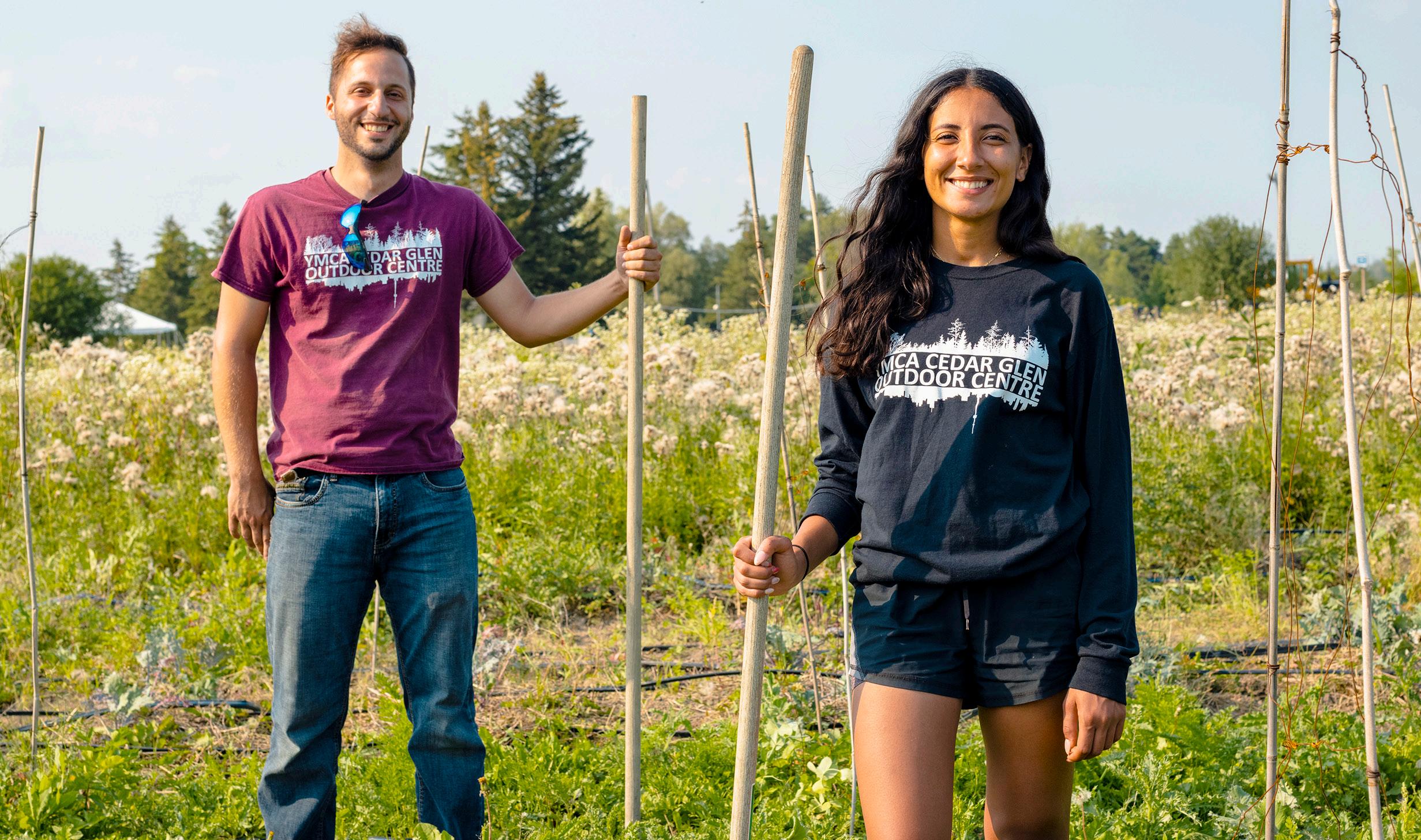
Continued
individual’s community in the modern age,” says Yerema. “Our communities are defined not so much geographically but by where we go, where we spend our time and how we interact. It’s about employers that demonstrate that they care, not just about their people, but about the world in which they live, and that try to mitigate negative aspects of their operations and listen to their people. So this list is very much practically oriented in how employers can reflect those values. It’s how do we get there?”
Naturally, too, when an organization makes major reductions in its water or energy usage, there can be financial benefits. Being a green employer can also be a boon for recruitment, given that so many young applicants are looking for solid evidence that a potential employer aligns with their values. “To be green doesn’t mean you’re just doing it because you feel good about doing it,” says Yerema. “It can actually be an engagement initiative.”
Not surprisingly, technology is becoming ever more present as organizations look to monitor metrics and engage with employees or, in the Toronto Zoo’s case, with visitors as well. At the waste bins In its restaurants, the zoo has set up Oscar sorting systems which use scanners and artificial intelligence to help patrons.

“It tells someone, that’s a pop can, that goes in recycling, or that’s a paper plate, it goes in composting,” says Greenham. “It gamifies the interactions.” Besides awareness, the system also creates macro statistics on how much waste has been diverted and emissions reduced, a key need for green employers. As with the zoo and plastics, Canada’s Greenest Employers are on a pathway to sustainability success.
– Berton Woodward
13 CANADA’S GREENEST EMPLOYERS (202 3) PROVIDED CONTENT
You’re not going to reduce pollution and emissions if you don’t address these things. The best way to do it is boring, mundane, dayto-day stuff.
– Richard Yerema Executive Editor
p Wildlife care keepers at the Toronto Zoo examine endangered black-footed ferrets.
TORONTO ZOO YMCA
p YMCA of Greater Toronto’s Cedar Glen location is home to an organic farm and a greenhouse built from recycled and reused materials.
ABB Canada is committed to the next generation
with electricity to decarbonize its heating system.”
The Canadian company is also working with customers to implement sustainable practices, such as electrifying rail lines to make it easier for commuters to get around while reducing emissions or charging 270 electrified school buses in the province of Québec to benefit children and communities.
Technology leader ABB Canada is globally on a journey to reach carbon neutrality by 2030, in line with its purpose of enabling a more sustainable and resource-efficient future with its technology leadership in electrification and automation.
“ABB has a diversified portfolio, so I’m able to work with passionate people from all the different technology and business areas within the company,” says Said Elaissi, health, safety and environment & sustainability national director. “Collaboration is one of our core values and it’s really brought to light when all
our business leaders come together to brainstorm on initiatives to fight climate change issues.
“What inspires me is that ABB makes it part of its purpose to take on the biggest challenge of our generation – global warming,” he says. “The need for action is more urgent than ever. We’re all working on something bigger than us, which is bringing solutions to the customer that will really benefit society’s needs.”
ABB’s 2030 sustainability strategy is supported by four pillars: to enable a low-carbon society, to preserve resources, to promote social progress, and to create a culture of integrity and
transparency.
“With our 2030 sustainability strategy, we’re actively enabling a low-carbon society as well as working with customers and suppliers to implement sustainable practices across our value chain and the life cycle of our products and solutions,” says Elaissi.
“ABB Canada is contributing to the company’s global commitment to support its customers in reducing and avoiding greenhouse gas emissions as well as achieving carbon neutrality across our own operations by 2030. For instance, one of the company’s biggest Canadian manufacturing sites near Montréal is replacing gas
— Said Elaissi Health, Safety and Environment & Sustainability National Director
“We are equally committed to providing impactful support for community-building initiatives,” says Elaissi. “Social equity in health, food security, energy access, employment and social rights is key to creating a sustainable society. That includes promoting social progress at ABB by building safe, fair, equitable and inclusive working environments where our people can succeed and develop.”
John Fragos, human resources communications specialist, says the social aspect is at the heart of sustainability and a big part of what he does at ABB.
“It’s important that ABB reflects the diversity that is Canada in both the people that work here

14 CANADA’S GREENEST EMPLOYERS (202 3) PROVIDED CONTENT
Leaders at ABB Canada collaborate to brainstorm initiatives that fight climate change issues.
What inspires me is that ABB makes it part of its purpose to take on the biggest challenge of our generation – global warming.
and the policies we’re putting forward,” says Fragos. “Doing so requires building a safe work environment that is inclusive and continuously committed to reducing workplace environment injuries, improving the employees’ sense of well-being, hiring diverse talent and creating a culture of
equal opportunities. It’s about ABB creating a place where people want to work.”

ABB has a long-standing tradition of active engagement in the communities. In addition to the company’s annual giving campaign, employees can access a platform throughout the year to

—
donate so they can support their charities of choice whenever they want. In the last five years, ABB Canada and its employees have donated well over $4.5 million CAD.
“We respond to natural disasters that may be occurring in Canada, such as the wildfires in B.C.,” says
Fragos. “I am lucky in that I can see first-hand how the work I’m contributing to has a meaningful impact. I am grateful to collaborate with the team working on deploying policies that will have a material impact on our different stakeholders not only today, but in the future.”
15 CANADA’S GREENEST EMPLOYERS (202 3) PROVIDED CONTENT
ABB Canada uses technology to achieve a more productive and sustainable future.
Contributing to a more sustainable world.
Make a positive impact by joining our team.
"ABBees" initiative with beekeeping partnership Building footprint includes EV charging stations Extended recycling includes e-waste
LEED-certified Canadian headquarters and Québec factory
Assiniboine Credit Union puts its values into green action

Founded 80 years ago, ACU today has assets of over $6 billion and is owned collectively by nearly 140,000 Manitobans who use its services. ACU currently operates 17 branches in Winnipeg as well as two northern branches in Thompson and Gillam.
An avid cyclist even in the teeth of a Winnipeg winter, Dennis Cunningham clearly practises what he preaches. As manager of environmental sustainability for Assiniboine Credit Union (ACU), Cunningham oversees the financial institution’s strategies for reducing its carbon footprint by encouraging employees to cycle, walk, carpool or take public transit rather than driving to work alone each day, among other things.
Incentives offered by ACU include subsidized bus passes as well as showers and secure bike lockups at many of its locations
for those who physically exert themselves on the way to work.
“Over the past decade, the number of employees who are drive-alone commuters has dropped from 63 per cent to 49 per cent,” says Cunningham, who cycles or runs 5K each way to work year-round. “Remote working, which about half our staff are still doing at least part of the week, is further reducing the level of commuting.”
The commuting initiatives are just one part of a comprehensive effort that has seen ACU cut its overall greenhouse gas emissions by nearly 50 per cent over the last 15 years, even as both its
membership and employee base steadily grew.
Among the measures ACU has taken to achieve those results: incorporating greater energy efficiency into new and existing buildings; harnessing alternative energy sources such as solar walls and geothermal; shifting from fluorescent to LED lighting; reducing the number of printers; and transitioning to 100 per cent recyclable paper and introducing more paperless processes.
Additionally, ACU has purchased carbon offsets and become the first credit union in Manitoba to achieve carbon neutrality.
ACU’s green initiatives are very much tied to its overarching commitment to values-based banking and its triple-bottom line of people, planet and prosperity.
“A big part of values-based banking is about engaging with members and employees to make a positive contribution to the community,” says Cunningham. “Our commitment to environmental sustainability is reflective of what we stand for and the impact we want to make.”
For example, a recent new member campaign resulted in a $20,000 donation to Trees Winnipeg’s ReLeaf Program, which is helping to restore the urban tree canopy, particularly in more impoverished areas of the city that otherwise wouldn’t have access to such funds.
An employee-led EcoExcellence Committee helps identify and
16 CANADA’S GREENEST EMPLOYERS (202 3) PROVIDED CONTENT
Dennis Cunningham educating branch employees about composting and recycling at Assiniboine Credit Union.
Our commitment to environmental sustainability is reflective of what we stand for and the impact we want to make.
— Dennis Cunningham Manager of Environmental Sustainability
guide priorities for environmental action. All of the volunteer members of that committee work in ACU departments that directly impact the credit union’s environmental performance or deal with employee engagement. Cunningham says that recruitment interviews reveal a
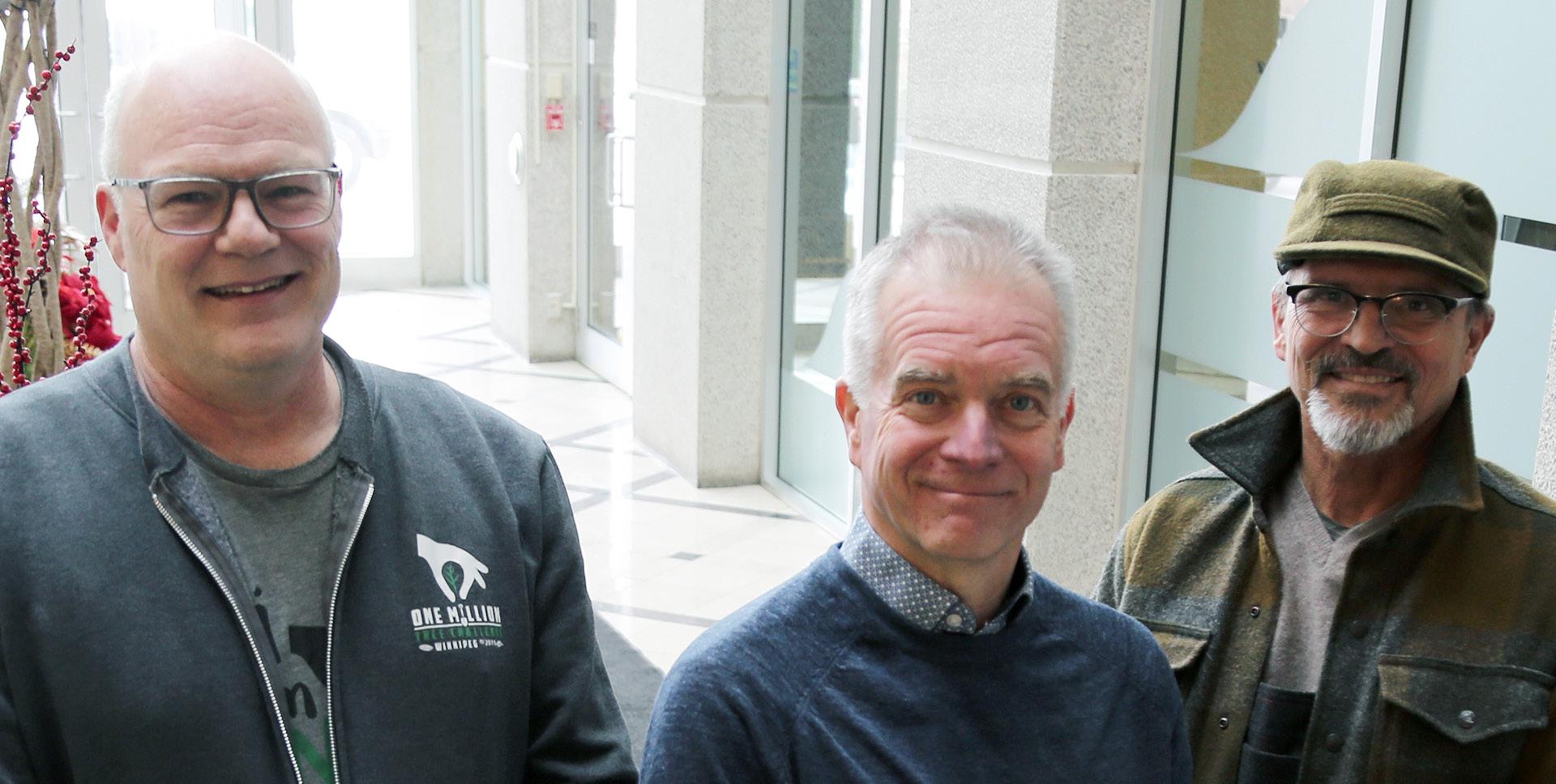
keen interest in ACU’s environmental undertakings.
“Increasingly, people are looking for potential employers with values that reflect their own personal priorities,” he says. “For many young people, a commitment to environmental sustainability is high on that list.”
The same is true of many long-time employees, including Steven Bennett, a 19-year ACU veteran who is currently financial account manager at the credit union’s Garden City branch, where he spearheaded the introduction of a successful composting program.
“The steps ACU has taken on many fronts to advance sustainability make me proud as an employee,” says Bennett. “I think that’s also true for many of our members. When it comes to our values, it shows we are not just saying these things; we are putting those values into action.”

17 CANADA’S GREENEST EMPLOYERS (202 3) PROVIDED CONTENT
Dennis Cunningham, manager of environmental sustainability (centre), at Assiniboine Credit Union, with an executive and director from Trees Winnipeg.
Carbon-neutral credit union
Commuter challenge
Trees Winnipeg neighbourhood forest renewal
Employee-led organic composting
Green living is part of the package at BC Housing
Livegreen Employee Council to produce webinars that bring in experts to discuss topics like green buildings, managing waste responsibly and other sustainability topics. It also connects with Royal Roads University to offer courses on climate adaptation, which are available to employees across BC Housing.
Choices about green lifestyles usually begin at home, but at BC Housing, employees are encouraged and assisted in making those choices. That’s thanks to programs like the Livegreen Employee Council, an employee group from across the organization tasked with helping set goals and make changes.
Christina Rosema, a senior communications specialist at BC Housing, is also chair of the Livegreen Employee Council, which was set up at the organization 13 years ago. It includes employees from across
the Crown agency who help staff achieve goals at home and at work that harmonize with the organization’s environmental goals.
“We focus our activities and campaigns around these major sustainability issue areas,” Rosema says, “like climate change mitigation and adaptation, pollution prevention, biodiversity protection, and appreciation of nature.”
The council works with departments like Human Resources to implement programs to help cut down individual carbon footprints. There are subsi-
dized transit passes, Bike to Work Week, discounts at retailers and a financing program to help fund bike purchases.
“We work to help people make more sustainable choices at home, at work and in the community,” Rosema says. That involves collaboration with departments at BC Housing like People, Plants and Homes; Energy and Sustainability; and Sustainability & Resilience.
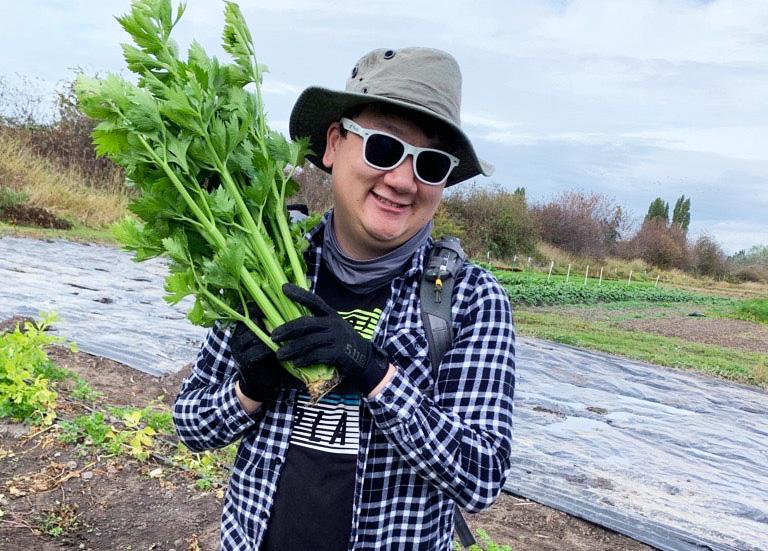
Magdalena Szpala is director of sustainability & resilience at BC Housing, which builds and runs social housing for the province. Her department works with the
In addition, “we work very intentionally with senior leadership to incorporate sustainability considerations into our business strategy, policies and activities,” Szpala says.
Environmental goals have been at the heart of the organization for years, she says, noting that it has been carbon neutral since 2010 and works to measure and reduce emissions annually, tracked with regularly published ‘Climate Change Accountability and Sustainability’ reports.
“Historically we’ve been focusing on the reduction of greenhouse gas emissions and energy efficiency. More recently, we’ve also been working on climate adaptation, as well as equity and environmental justice,”
18 CANADA’S GREENEST EMPLOYERS (202 3) PROVIDED CONTENT
A BC Housing employee harvesting celery at a farm to donate to food banks.
We work very intentionally with senior leadership to incorporate sustainability considerations into our business strategy, policies and activities.
— Magdalena Szpala Director, Sustainability & Resilience
Szpala says.
While these green initiatives are an obvious fit for an organization like BC Housing, Rosema thinks they can be put into use in almost any workplace. She recalls taking an online course recently and having someone else in the class from a different company reach
out to talk about the work she was doing on Livegreen.
“That was really exciting to share,” she says. “I feel like there’s a real appetite for that.”
Szpala says that working with Livegreen representatives has been personally inspiring for her as well. A vegetarian for decades,
she noticed that many council members were vegan. “I thought that seemed like an easy jump, but I actually found it really hard,” she says.
“I really admire my colleagues who are vegan and who share tips and ways to make it easy and fun. They’ve been a great inspiration
for me in my personal life.”
As for the council’s main work, says Rosema, “we can reach so many employees and connect them to our sustainability goals and outreach – to keep it in focus and remind everyone of the importance of it in all aspects of our lives.”
bchousing.org

19 CANADA’S GREENEST EMPLOYERS (202 3) PROVIDED CONTENT
BC Housing employees volunteering at a neighbourhood cleanup in Penticton.
We’re proud of our professional, compassionate, forward-thinking employees who make a positive di erence in this province every day.
Building footprint includes EV charging stations Green procurement strategy Partnership with community organizations Annual employee sustainability survey
Bell Canada pursues a carbon-neutral future
2021. By the end of 2023, Bell hopes to recycle seven million electronic devices, including mobile phones, television receivers, modems and Wi-Fi pods, which Bell customers return via their Bell Blue Box e-waste recycling program.
After earning a degree in sustainability in business from McGill University in 2016, Monika Potocki knew Bell Canada was where she wanted to launch her career.
“When I was a student, we had someone from Bell’s corporate responsibility team make a presentation about the company’s strategy and I told myself I need to be on that team,” says Potocki, a specialist in environmental, social and governance (ESG).

That was her goal, but it took her a while to land that dream job.
Potocki joined the graduate leadership program and spent her first three years in Bell’s operational divisions, Bell Technical Solutions and Bell’s Field Services, which are responsible for several thousand technicians who connect Bell residential customers in Ontario and Québec with television, internet and home phone services.
“I was a cheerleader encouraging our technicians to recycle modem and receiver boxes and to do other things for the environment,” says Potocki.
When it comes to sustainability,
every little bit helps. But more broadly, Bell has launched a number of big programs and initiatives to reduce the company’s greenhouse gas (GHG) emissions and carbon footprint. “We have a goal to be carbon neutral for our operational GHG emissions starting in 2025,” she says. “And we have set science-based GHG reduction targets to ensure that we are verifiably doing our fair share to meet Canada’s Paris Agreement commitment.”
Among the more ambitious measures was a three-year program launched on January 1,
“We refurbish modems to give them a second, third or fourth life,” says Potocki. “We recycle and resell cell phones whenever possible. If a phone is defective, we send it to a certified recycler who dismantles it and removes anything of value, like gold and copper.”
The company donates the annual net proceeds to WWF Canada to support the organization’s campaigns to fight biodiversity loss and preserve ecosystems.
Bell is in the early stages of a multi-year program to convert thousands of its fleet of 11,000 vehicles from internal combustion to battery electric by 2027. “A big challenge for us these days is electric vehicles,” says Andrew Savage, senior manager, real estate
20 CANADA’S GREENEST EMPLOYERS (202 3) PROVIDED CONTENT
Monika Potocki, senior specialist, environmental, social and governance, at Bell Canada.
When you look at the full scale of our programs and initiatives, you see how sustainability trickles down to the day-to-day work of every employee.
— Monika Potocki Senior Specialist, Environmental, Social and Governance
and environment with Bell. “But the pace of conversion is impacted by supply chain issues as well as the capital cost of the vehicles and the charging networks.”
His division will be operating some 5,500 vehicles at 2023 peak, comprising a mix of cars used by managers and vans for techni-
cians. In 2021, Bell introduced 30 battery electric cars. Last year, the division acquired 50 electrically powered vans and plans to convert 157 vans this year.
To date, Savage’s division has been able to keep the first 80 electric vehicles on the road with only 30 charging stations.
Company-wide, BCE had installed 200 chargers by the end of 2022 and had replaced 274 vehicles with more fuel-efficient models.
The company’s environmental programs extend to reducing the carbon footprint in hundreds of offices. Whenever possible, Bell converts from fluorescent to LED

lighting, installs low-flow plumbing in washrooms, and has motion sensors that turn lights on or off depending on occupancy.
“When you look at the full scale of our programs and initiatives, you see how sustainability trickles down to the day-to-day work of every employee,” says Potocki.
21 CANADA’S GREENEST EMPLOYERS (202 3) PROVIDED CONTENT
Bell Canada installs motion sensors that turn lights on or off depending on occupancy in its offices.
Consumer-facing waste recycling program Green procurement strategy Programs include noise pollution initiative In-house and external environmental audit
Cadillac Fairview is building towards net zero
journey where we no longer have low hanging fruit,” she says. “As a result, we’re innovating and even looking at artificial intelligence for select properties, such as how we heat and cool our buildings. We’re extremely committed and really trying to push the boundaries.”
As one of the first Canadians to hold a full-time sustainability role, Karen Jalon is a pioneer in establishing green building standards in North America. When she was hired by Cadillac Fairview Corporation Ltd. (CF) in 2008, Jalon recalls it was a time when there weren’t any industry best practices.
“My initial role was interpreting what sustainability meant in the commercial real estate space and how CF could be an industry leader,” says Jalon, vice-president, sustainability, energy and smart
technology. “We quickly learned to have clear targets and standards for our properties as well as leading technologies and capital investments, but what really catapulted us ahead was integrating sustainability into our culture and empowering our people to make a real difference.
“We built Canada’s first operationally focused sustainability program, called Green at Work, that really supported all the green teams at the property level in achieving real results. It’s been a very award-winning journey.”
CF’s Green at Work program focuses on three key pillars: first,
wellness; second, climate action, involving emissions and climate resilience, including mitigating the company’s impacts on the environment and adapting to a changing climate; and third, resource protection, such as water and waste management.
“It’s a very holistic program, encompassing very material aspects of sustainability across the board and thinking about how to integrate and operate on a daily basis in the most efficient way,” says Jalon. “It’s what has led us to a 56 per cent reduction in emissions since 2008.
“CF has gone through a long
Cadillac Fairview has committed to achieving net-zero emissions in its real estate portfolio by 2050 and recently announced its Zero Carbon Building Performance Standard certification for seven buildings in its Vancouver office portfolio.
As general manager of CF’s Waterfront Properties in Vancouver, Jesse Gregson is responsible for running four commercial office buildings with his team. That includes managing emissions, energy conservation and water conservation.
“We’ve had a strong sustainability program in place, helping us on that path for some time,” says Gregson. “From an emissions efficiency standpoint, essentially these are high-performing buildings and we have a good roadmap to see us through to net

22 CANADA’S GREENEST EMPLOYERS (202 3) PROVIDED CONTENT
Cadillac Fairview has committed to achieving net-zero emissions in its real estate portfolio by 2050.
Being able to tell your kids that what you do at work has a direct positive impact on climate change is something people are really proud of.
— Jesse Gregson General Manager, Waterfront Properties
zero. We have good operations policies, procedures, programs and technology in place to operate the buildings as efficiently as we can. In many cases, we’re going to be ahead of that 2050 target.”
Gregson says heating the buildings is where most emissions come from, so the company is
always looking for opportunities to reduce those, such as a project involving the installation of a geo-exchange system, a retrofit, to one of the existing buildings.
“We can have heat-sharing between an office building and a retail building that are side by side, and extract heat out of the


geo field in the ground when we need it,” says Gregson. “The Geo-Exchange system has reduced CO2 emissions at 777 Dunsmuir by an estimated 473 tons per year.”


Gregson says CF supports environmentally friendly projects even when they don’t meet traditional financial criteria.
“CF gives people the opportunity to bring forward ideas that will help us on that journey,” says Gregson. “Being able to tell your kids that what you do at work has a direct positive impact on climate change is something people are really proud of. It brings purpose to your job.”
23 CANADA’S GREENEST EMPLOYERS (202 3) PROVIDED CONTENT
Transforming Communities for a Vibrant Tomorrow
Cadillac Fairview installed a geoexchange system at its 777 Dunsmuir building to reduce carbon emissions from heating energy.
cadillacfairview.com/careers
Established energy and emissions target
Rooftop beehives housing over 350,000 honeybees
Sub-meters with access to real-time energy data Green at Work employee teams
Environmental stewardship is a journey at Canon Canada
continuous environmental improvement is something that resonates with Nazly BeltranAlcazar, an environmental affairs associate specialist in the company’s Brampton office. An environmental engineer and project manager by training, Beltran-Alcazar first considered a career in environmental sciences after watching the documentary An Inconvenient Truth.
“Something clicked with me, and I wanted to do something to help ease those impacts,” she says.
The beginning of a new year is always a time for reflection and goal-setting. At Canon Canada, that’s especially true for the organization’s green team, a company-wide, cross-departmental committee that develops and leads its environmental initiatives.

Over the first few months of 2023, the green team has been meeting to assess the success of last year’s programs and how they could be improved this year, to look at the company’s environmental goals and the risks it needs to mitigate, and to consider adding any new environmental initiatives.
That goal-setting is a reflection of the mindset, for the company and the green team, that environmental stewardship is an ongoing process, says Leena Nagpal, vice-president of human resources, general and environmental affairs and corporate communications. “It’s a journey,” says Nagpal. “You just have to keep doing new things every single year.”
The company has no shortage of environmental initiatives. Its electronics and battery recycling programs allow employees to drop off end-of-life products they no longer need so they are properly recycled. For employees and
customers alike, toner cartridges can be returned to Canon for recycling at its Virginia facility, where the materials are broken down to find second life as raw materials in other products or applications.
At its Brampton, Ont., headquarters, the company installed rainwater collection basins for a grey water system. Once the rainwater has been filtered, Canon automatically shuts off its city water access and uses the grey water for flushing and irrigation. Last year it met its goal of reducing its city water intake by 20 per cent.
Canon Canada’s focus on
While she notes the scope of the work can feel daunting, she sees the company’s commitment to constantly finding ways to improve as inherently optimistic.
“I love it. Every day you have to think about the things you can do better; it’s work that’s never done,” she says. “We’re always looking for ways to improve our performance internally and externally.”
Beltran-Alcazar, whose work involves maintaining the company’s environmental policies and procedures and setting objectives for the year, says she was initially drawn to apply to the company because of its environmental commitments
24 CANADA’S GREENEST EMPLOYERS (202 3) PROVIDED CONTENT
Canon Canada employees planting trees and installing beaver guards at a group event.
We’re always looking for ways to improve our performance internally and externally.
— Nazly Beltran-Alcazar Environmental Affairs Associate Specialist
and numerous programs, including its annual Branch Out volunteer initiative. During Branch Out, employees can spend multiple workdays creating green spaces and sustainable environments in their communities by planting trees, removing invasive species and building habitats for

local animals.
According to Nagpal, roughly 40 per cent of Canon Canada employees participate in Branch Out every year, and company employees have planted just shy of 7,000 trees. “Everyone wants to give back to the community and reduce our environmental

footprint,” she says.
In 2022, her first full year at the company, Beltran-Alcazar got to participate in six Branch Out events, not just as a volunteer but also working behind the scenes to make sure they went smoothly. After a day spent doing the physical work of removing
invasive species, she says she was exhausted – but exhilarated, too.
“I was able to meet a lot of new people and travel to other locations outside of Brampton,” she says. “It was exciting to participate and get to have a positive impact in the communities we work and live in.”
25 CANADA’S GREENEST EMPLOYERS (202 3) PROVIDED CONTENT
Canon Canada promoting environmental awareness and sustainability at the 2022 ‘Japan Festival CANADA’ in Mississauga, Ontario.
Formal employee green team
Canon Americas Environmental Charter Branch Out program supports community initiatives Building footprint includes rainwater collector
At CIBC, a sustainable future is a goal for everyone
climate-related ideas from CIBC employees and work with product developers, digital teams and other groups “to integrate sustainability into our personal and business banking operations,” she says.

their carbon footprint.
Other teams across the bank invite her to make presentations to team members to alert them to CIBC’s climate-change initiatives.
“My role is to bring teams together,” she says, “and to make sure that what they do aligns with the overall strategy of the bank.”
While the online Climate Centre offered by CIBC encourages clients to share the bank’s commitment to sustainability, it also supports Erin Gillis as she engages with colleagues in developing climate-related ideas.
The site invites visitors to explore “how to transition to low-carbon living while integrating climate action into their everyday life.” They can
learn more about the real cost of food waste, for example, and how to save energy with the ‘Canada Greener Homes’ program.
“The site encourages consumer awareness,” says Gillis, CIBC’s director of client strategy, “and brings all our sustainable solutions for individuals and families to one place.”
Since it went live in 2022, Gillis and her team have added a wealth of new information, including a buyer’s guide to home electric vehicle chargers and a primer on
sustainable investment choices.
“We’ve pulled in some existing banking solutions and added new ones,” she says. “As CIBC comes out with more solutions incorporating sustainability, we can post them there. The emphasis is on education, engaging with our teams, our clients and our communities, to help them to reduce their carbon footprint.”
At the same time as they edit and refine the site’s content, Gillis and her client strategy team gather
To ensure this alignment, Gillis works closely with Josh Picov, executive vice-president, strategy and transformation, on CIBC's personal and business banking team. Their team’s current initiatives are presented to the members of the bank’s senior executive environmental, social and governance (ESG) council. The council was established to ensure co-ordination on enterprise-wide ESG initiatives, enhance connectivity among leaders and team members and build awareness and knowledge throughout the bank.
“My job is to consolidate ideas
26 CANADA’S GREENEST EMPLOYERS (202 3) PROVIDED CONTENT
Erin Gillis, director, client strategy, works with teams across CIBC to develop sustainable banking solutions for clients.
The emphasis is on education, engaging with our teams, our clients and our communities, to help them to reduce
— Erin Gillis Director, Client Strategy
and feedback from industry experts and leaders across the bank,” says Picov. “I share with the council what we’re hearing about climate change in client conversations, and what we’re doing to help them take charge of their own carbon footprint.”

Responsible for ensuring that

CIBC's retail business addresses current consumer trends, Picov works closely with Gillis on her climate-related activities.
“Erin’s spearheading a lot of innovative work across a range of solutions and she’s developing partnerships and educational resources for the Climate Centre,”
says Picov. “Building a sustainable future is embedded in how we do business with clients, whether they’re in our retail, wealth management or capital markets business.”
For Gillis, the bank’s collaborative culture helps her to harness employee enthusiasm for
sustainability in a way that reinforces CIBC’s environmental strategy.
“Sustainability isn’t a standalone program,” she says. “It’s just a matter of bringing everyone’s ideas all together. When you get that right, you can make a real impact.”

27 CANADA’S GREENEST EMPLOYERS (202 3) PROVIDED CONTENT
Josh Picov, executive vice-president, strategy and transformation, at CIBC continues to support efforts to tackle climate change.
cibc.com/CT100
In-house waste reduction and recycling
Mortgage loan product for greener homes Green power purchasing program
Green Bond to help mitigate climaterelated risks
Desjardins engages its staff in the climate challenge
committed to reducing its carbon emissions to 41 per cent below 2019 levels by 2025. It’s also turned down many financing requests it’s received since 2018, mostly from mining and oil and gas companies, for not meeting its environmental, social or governance criteria, and is developing responsible investing and saving options for clients.
Desjardins Group has ambitious goals to become carbon neutral as a business by 2040, so the organization is empowering its employees to help meet the challenge head-on.

The Levis, Que.-based financial co-operative’s Cooperating for the Climate Challenge aims at getting employee buy-in in key priorities for the organization, such as
reducing paper consumption, business travel, energy usage in the buildings it owns, and improving the environmental footprint of its supply chain.
“Employee buy-in is the difference,” says Maricarmen Ubeda, who is senior advisor in Desjardins’ sustainable development and responsible finance branch and led the development of the challenge.
“This specific project is not only
an initiative that will help us get to our goal, but it will also be employees’ work – if an employee chooses not to travel this month and have a virtual meeting instead, it helps. With so many employees in the organization, small changes can have a big impact.”
Desjardins was the first Canadian financial institution to sign onto the Business Ambition for 1.5 C coalition and has
Cooperating for the Climate Challenge was developed to help employees see how they could play a role in those big-picture goals, says Gildas Poissonnier, senior director of the sustainable development and responsible finance branch.
“Obviously to get there we need targets and concrete programs for employees to understand what they need to adjust or change,” he says.
Poissonnier notes that Desjardins also has incentives to help employees make greener choices, like encouraging staff who travel for work to use a hybrid or electric model car, and offering discount public transit passes, on-site showers and lockers and
28 CANADA’S GREENEST EMPLOYERS (202 3) PROVIDED CONTENT
Marie-Josée Dumouchel, an employee at Desjardins Group, planting trees.
With so many employees in the organization, small changes can have a big impact.
— Maricarmen Ubeda Senior Advisor, Sustainable Development and Responsible Finance Branch
reserved carpool parking spaces to encourage sustainable mobility.
Ubeda says employees are excited to participate, and the team managing the challenge, which has grown to 60 employees, is regularly fielding questions from staff members across the organization about how they
can help.



That was part of the reason the team developed a training on the principles of sustainable development and responsible finance, which was completed by over 90% of employees and managers in 2022.
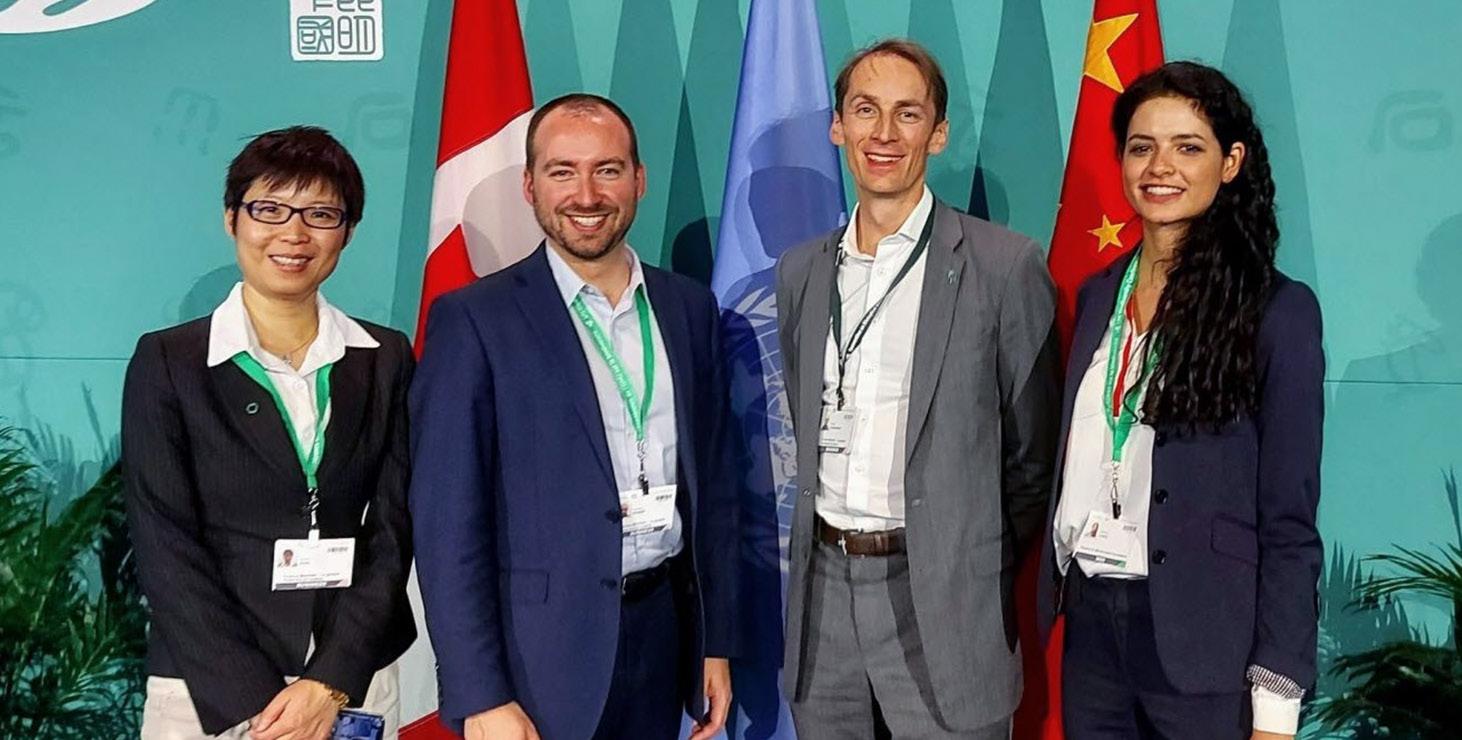
Since rolling out the training








programs, “we’ve had people really motivated to start doing things in their own jobs. They’re really happy to do it,” Ubeda says.
Ubeda, who joined Desjardins in 2018, says she was initially interested in working for the company because of its reputation in Québec as forward-thinking on


climate change. Nearly five years later, she says the organization is all that and more.
“You can feel that it has green blood, and not just because of the colour of the logo,” she jokes. “You can see it in the tangible actions and the things they do for the community and society.”



29 CANADA’S GREENEST EMPLOYERS (202 3) PROVIDED CONTENT
Desjardins Group employees from the sustainable finance and responsible finance teams attending The United Nations Biodiversity Conference.
Find out for yourself! Join the Desjardins team. desjardins.com/careers
We’re not just a potential employer. We’re the employer of choice for over 56,000 people. There’s a difference.
Green auto loans and discounted insurance
Business loans to reduce energy consumption
GoodSpark Fund for sustainable development Alternative transportation program
Durham College grows its own green future
production. “If we don’t grow what we need on the farm, we buy local whenever possible, and most of our wines are from Ontario,” Baksh says. “We even have fish tanks at the farm.”
According to president Don Lovisa, the sustainable food program is just one of many green initiatives at Durham College. The organization has reduced its greenhouse gas emissions, for example, through the installation of geothermal fields, green roofs and solar panels.

Green can mean many things to a lot of organizations, but it has a more literal meaning for Oshawa and Whitby, Ont.-based Durham College of Applied Arts and Technology. It operates a sustainable agriculture program that educates and supports its employees and students.
The college’s W. Galen Weston Centre for Food (Weston Centre), part of the Faculty of Hospitality & Horticultural Science, grows greens and much more on a one-acre farm; prepares and
serves it at the award-winning Bistro ’67 restaurant and Pantry retail store; and develops ways to responsibly reuse, recycle and compost the waste products.
At Pantry, technician Anna Mae Baksh makes and sells prepared foods, baked goods, preserves, salads and ready-to-make meals. She also invents new ways to use the farm’s products and keep any excess from being wasted.
“We really try to reduce our food waste,” she says. “The farmers grow ingredients for the culinary programs, and sometimes there’s a surplus, which is where I come in.
One year there was a lot of zucchini, so I made a crumble, and when we had a surplus of cucumbers I made a bunch of relishes. We’re also getting a bio-digester, which turns food waste into compost for the farm.”
The Weston Centre uses compostable and recyclable packaging and materials, and works to source suppliers that do the same, while the Barrett Centre of Innovation in Sustainable Urban Agriculture addresses challenges including food insecurity, access to fresh food and regeneration of land for local food
Don Lovisa President
“For many years we’ve had conversations about sustainability, and they’ve resulted in great programs,” he says. “A few years ago, there were incentives like selling energy to the grid and buying it back at a lower price, and Durham College was pleased to get involved and challenge our facilities professionals to find better, more sustainable ways of operating our campuses.
“We achieved this through a series of initiatives, such as changing the lighting in buildings and installing different control systems to reduce energy consumption. Those programs helped get us started, and inspired us to keep going as we recognized
30 CANADA’S GREENEST EMPLOYERS (202 3) PROVIDED CONTENT
The geothermal field and LEED gold-certified Centre for Collaborative Education at Durham College.
Sustainability is part of our culture, and an important factor in how we plan and execute our projects.
—
the benefits.”
Lovisa stresses the importance of motivating the entire organization to get involved in the transition to greener operations, from senior executives and building maintenance employees to faculty members and students.
“People know that at a
leadership level, we’re receptive to ideas to improve our operations from a green perspective,” he says.
“We encourage everyone to share their ideas and join the conversation so we can continue to find innovative solutions.”
Now, the whole college has adopted green thinking.
“Sustainability is part of our culture, and an important factor in how we plan and execute projects,” Lovisa says. “We’ve opened our first LEED Gold building on campus, and the geothermal plant we installed supports one of our oldest buildings and reduces our

greenhouse gas emissions.
“We’re always updating our campus buildings, installing new mechanical systems that are more efficient and using less electricity, so we save money too. This collective effort demonstrates how we’re leading the way to a greener and brighter future.”
EDUCATING THE NEXT GENERATION OF SUSTAINABLE EXPERTS
With themes of social and environmental sustainability throughout many of our programs, together, we’re leading the way to a greener future.
31 CANADA’S GREENEST EMPLOYERS (202 3) PROVIDED CONTENT
A student training in urban and sustainable agriculture practices at Durham College.
STARS Silver certified campus On-campus geothermal field saves enough energy to power an average home for 136 years
LEED Gold certified learning spaces Launch of new urban agriculture hub of excellence
Evolugen applies green principles across the board
the ESG program receives from Evolugen’s management. “The ESG team includes our top executives, and we have quarterly meetings to update our targets and discuss any challenges,” she says. “And we’re researching things like hydrogen and battery storage to support the whole industry’s transition, not just ours.”
When your business is providing sustainable power solutions, it makes sense to operate in a building that’s as energy-efficient as possible. So it’s no surprise that the head office of Evolugen, the Gatineau, Que.-based renewable energy company, sets a high standard for environmental innovation.
Evolugen’s employees work in a LEED-certified building that overlooks the Ottawa River and
the Parliament Buildings. “It’s beautiful, with lots of natural light and amazing views,” says Emily Zhang, senior sustainability analyst on Evolugen’s environmental, social and governance (ESG) team.
The company’s ESG program looks at its strategy and performance on climate change, biodiversity, water management, community relations, Indigenous relations and health and safety.

“It’s a dream job for me,” says Zhang. “We support other companies’ transition to a more
sustainable, low-carbon future, and we also work to improve our own performance. We’ve been carbon neutral since 2020.”
Evolugen has environmental and social committees to engage employees and encourage them to work together to improve its green performance, and a wellness program that offers on-site yoga and fitness classes. There’s even a rooftop garden where Evolugen employees grow fruits and vegetables that are harvested and donated to a nearby kindergarten.
Zhang appreciates the support
According to Jonathan Lee, vice-president of human resources, it’s important to apply the same sustainability principles across the board at Evolugen, from major energy projects in other provinces to coffee machines in the office.
“These days everyone wants to know where their coffee comes from, and it’s the same with power,” he says. “People want to know: Is it green? What powers it? Where do our solar panels come from and how are they built?”
So the company engages in extensive research and discussion to come up with the greenest and most innovative solutions – for itself as well as its clients.
“There’s a lot of inner reflection
32 CANADA’S GREENEST EMPLOYERS (202 3) PROVIDED CONTENT
An Evolugen employee at the Kokish River hydro facility in Telegraph Cove, B.C.
We support other companies’ transition to a more sustainable, low-carbon future, and we also work to improve our own performance.
— Emily Zhang Senior Sustainability Analyst
on everything we do,” Lee says, “whether it’s as simple as not having disposable cups or plastic in the cafeteria, or larger things like our fleet vehicles, which we’re converting to hybrid or electric where the technology exists. We figure out what else we can do and challenge ourselves.”
“We have biodiversity principles integrated into our decisionmaking,” adds Zhang. “We want to make sure that if we build new sites or new developments, we can avoid and mitigate risk. We work with partners on things like tree planting, we support environmental initiatives and we develop
science-based solutions for climate-related issues. That’s really important, and it’s in place across the whole business. From operations to office management, it’s all aligned.”

Lee believes that approach results in a culture that encourages innovation and
entrepreneurialism. “At the end of the day, we’re solving problems that we don’t know exist yet, to challenges we haven’t come up with yet,” he says. “The culture is so collaborative, and we spend so much time trying to be innovative and looking at problems from different angles. It’s exciting.”

33 CANADA’S GREENEST EMPLOYERS (202 3) PROVIDED CONTENT
Evolugen employees at the LEED-certified headquarters in Gatineau, Québec.
Head office building includes EV charging stations
25 biodiversity and conservation projects in 2022
Publishes biennial sustainability report Carbon-neutral since 2020
G&W Electric energizes employees on sustainability
leadership, G&W Electric’s green team has introduced a series of sustainability initiatives at its 210,000 square-foot base facility in Brampton.
Over a 33-year career at G&W Electric, Debbie Ellis has always found her employers supportive of her interests and passions. And in recent years, Ellis’s biggest passion has been sustainability.
“Fostering environmental leadership in the electrical industry is something I take very seriously,” says Ellis, Ontario sales manager for the Brampton, Ont.-based company, which delivers innovative electrical power grid solutions and products. “I’ve seen what’s happening with climate change and I desire a positive future for my grandchildren, nieces and nephew that
is sustainable.”
In 2013, Ellis became a founding member of Women in Renewable Energy (WIRE), which has grown into a global organization. In addition to advancing the role and recognition of women in the clean energy sector, WIRE also regularly sponsors workshops, conferences and field trips that help promote awareness about renewable energy solutions.
“G&W Electric gave me the time and support to serve on WIRE’s advisory committee for five years,” says Ellis. “They also stepped up immediately to provide sponsorship to help get this organization founded.”
In 2022, Ellis was selected to
participate in a subgroup that drafted a sustainability statement for G&W Electric’s global operations, the first step in putting together a comprehensive sustainability plan.
On Earth Day 2022, she also served as part of a volunteer G&W Electric team that helped clean up a local Brampton park.
“It’s good to be part of a company that’s taking positive actions on the environment,” says Ellis. “I feel like I’m making a difference.”
Continually improving G&W Electric’s environmental performance is a big part of the job for Dave Taylor, the company’s operations director. Under his

For example, in 2020, G&W Electric’s landfill diversion rate (i.e., the amount of generated waste not sent to a landfill) stood at 74 per cent. The company began recycling wooden pallets and sand as well as personal protection equipment, including COVID-19related masks and gloves. Other steps included using more visible recycling bins and ensuring work rags that had previously gone to the landfill were laundered and reused.
All of the programs involved employee education and training, and the combined effect was both immediate and impressive: G&W Electric’s 2021 landfill diversion rate increased to 86 per cent.
In 2022, the company continued to improve its landfill diversion rate by removing all disposable cups, reducing paper towel use by 80 per cent and introducing a green bin program for organic waste.
G&W Electric also invested
34 CANADA’S GREENEST EMPLOYERS (202 3) PROVIDED CONTENT
Benjamin Mendoza, an employee at G&W Electric, working on switchgear.
It’s good to be part of a company that’s taking positive actions on the environment. I feel like I’m making a difference.
— Debbie Ellis Sales Manager
$300,000 to replace fluorescent lights with energy efficient LED lighting throughout its shops and offices.
Employees have embraced these efforts, says Taylor.
“People are realizing it doesn’t cost a lot to achieve these objectives and that it’s very much a
team effort,” he says. “For example, we were spending $800 a month on disposable coffee cups and stir sticks. In addition to keeping those items out of the landfill, the cost savings are being split evenly between the company and G&W Electric’s employee profit-sharing plan.”

Similarly, the new LED lighting is reducing energy costs by $9,000 a month, while also improving employee morale.
“It’s a cleaner, brighter light and people say they feel more energized,” says Taylor.
In addition to being the right thing to do, undertaking green

initiatives helps make G&W Electric a more attractive employer, he says.
“When we interview job candidates, many are now asking what we are doing for the environment,” says Taylor. “That’s a cultural shift and something you didn’t see even five years ago.”

35 CANADA’S GREENEST EMPLOYERS (202 3) PROVIDED CONTENT
G&W Electric employees at an Earth Day clean up event in Brampton, Ontario.
Electric vehicle charging station powered by solar panels
Informal employeeled green initiatives
In-house and external environmental audit
Partnerships with community organizations
Achieving a greener world underlies all things at Hatch
the environment underlies everything that we do at Hatch.”
Over the course of her 17-year career at Hatch, Vukovics has seen awareness of environmental impact, and the need to look at it holistically, grow exponentially from all sides. “Our clients, who have to meet new regulatory requirements and want to be known as environmentally responsible companies, demand it,” she says. “Our employees, especially the new generation, want to be part of the fight against climate change. And we have complete support all the way up to the board and CEO.”
When Montréal’s ongoing transit expansion required new and modified bridges for its trains, Hatch Ltd. aquatic biologist Carol Zastavniouk went to work. “When you’re putting up a new bridge, you are automatically affecting valuable fish habitat, either temporarily with the structures used to build it, or permanently with the bridge itself,” she says.
“So, for these kinds of projects, you have to quantify exactly what’s there originally, quantify exactly the impact you’re going to have, and then try to mitigate that as much as possible in the design and the construction methods,” Zastavniouk explains. “Once you calculate that, even with all our mitigation measures, this is how much impact we’re still going to have, then you compensate for it. That’s where building a new spawning ground for the fish
comes in.”
Kathleen Vukovics, regional director, environment and sustainability, at Hatch, still encounters people who express surprise that the engineering firm employs fish biologists. “We do get that a lot, actually,” she says, “and it’s one of the reasons we’ve started to call ourselves a professional services firm, which is more reflective of our diverse skills beyond engineering. The fight against climate change and protection of
It’s become a huge area of growth for Hatch, Vukovics continues. “We’re all about solving our clients’ toughest challenges, and that means helping them navigate a changing climate.”
Vukovics, whose own expertise lies in human geography – the study of the complex interrelationships between people, place and environment – began her career consulting with Indigenous communities about the impact of

36 CANADA’S GREENEST EMPLOYERS (202 3) PROVIDED CONTENT
Hatch incorporates sustainable design and construction methods for its clients.
We’re all about solving our clients’ toughest challenges, and that means helping them navigate a changing climate.
— Kathleen Vukovics Regional Director, Environment and Sustainability
Extensive waste management programs
Dedicated group for sustainable design in projects

Sustainable Development Week

Installation of 10 EV charging stations
hydro and wind projects in Ontario. Now she is involved in Hatch efforts to help clients realize what changes would be most impactful for them.
“The last few years we’ve been using life-cycle analyses, looking at the whole footprint of a project, from extracting materials out of
the ground all the way to disposal at the end of life, to know what makes the biggest impact,” says Vukovics. “It’s not always immediately apparent – you can select less carbon-intensive materials for construction but find they’re not overly energy efficient. Carbon accounting and energy
modelling of a development or asset can help our clients make the least carbon-intensive choices.”
Or to see how best to compensate for environmental disruption, especially at the level produced by Québec’s largest public transit project in the last 50
years, Zastavniouk says. “We’re building a new spawning ground for walleye and sturgeon just north of Montréal, near one of the bridges being modified for this project.
“It’s a big project itself for the fish,” says the biologist, chuckling, “and for fish people like me.”
37 CANADA’S GREENEST EMPLOYERS (202 3) PROVIDED CONTENT
Photographer Edward Burtynsky, whose work focuses on the impact of humans on the planet, is joined by Hatch chairman and CEO, John Bianchini, for a presentation at the company's office in Mississauga, Ontario.
For Humber College, sustainability is an innate value
investments. “It’s not something we just embarked on,” says Puri. “We’ve been on this journey for a long time.”
The long-term plan is to wean the college off natural gas: recently constructed buildings on campus work on net-zero energy; future buildings will be net-zero carbon. Its newest 360,000 square-foot building, the Humber Cultural Hub, will use geothermal heat from 800 feet below ground level. Photovoltaic panels placed on the rooftops will convert light into electricity.
At Humber College in Toronto, students in every program learn how sustainability impacts their areas of study and the professions they are pursuing. A culinary student, for example, is taught to apply knowledge of sustainability, ethical and local food sourcing, and food security to food preparation and kitchen management. It is an integral part of the Humber education.
“It’s like your own children,” says Sanjay Puri, vice-president of administration and chief financial
officer. “You teach them when they’re young to switch off the lights as they’re leaving the room, and it becomes an innate habit.”
The commitment to sustainability permeates every facet of Humber College – from its curriculum and its food service to its community connections and recycling and energy conservation programs, as well as its approach to building and renovation.

“Sustainability is a core value –it’s in our way of being, in our way of behaving, we work to embed it into everything we do,” Puri adds.
“And it’s also how we educate
students to get them ready for the future while helping them understand their connection to the world and their ability to make a positive impact on it.”
Incorporating a sustainability mindset is nothing new for Humber College. In 2010, the school started by addressing its paper usage. Five years later, Humber instituted an integrated energy master plan, which will see a $65-million investment in energy conservation measures over a 20-year period.
Since then, the school has made about $35 million worth of
Through it all, Humber has engaged students. “Every inch of space at the campus is a learning lab – a classroom where students get to see, behave and learn from all the different measures the college is taking,” he adds.
Indeed, there’s even an academic component to the school’s massive SWITCH decarbonization project, which will reduce fossil fuel use by 70 per cent at the college’s largest campus through heating infrastructure changes and retrofits.
Aman Hehar is the associate director of energy and climate change and oversees these projects. Not only do contractors and engineers hire some of the
38 CANADA’S GREENEST EMPLOYERS (202 3) PROVIDED CONTENT
Humber College students and staff planting trees to build a natural habitat for wildlife and improve water quality in Humber Pond.
It is our purpose and our mission to create the global citizens of tomorrow.
— Sanjay Puri Vice-President of Administration and Chief Financial Officer
400 students from 32 countries joined Global Systems Gap Challenge SWITCH project to reduce overall institutional GHG emissions by 30%
students to work, but Hehar’s team develops project-related programs and challenges for fourth-year students. “They have to present to the actual construction teams, not their professors,” says Hehar. “And then they get real-world feedback from the companies that are working on this.”
He adds that Humber College is keen to educate other institutions and cities about its successes and challenges with deep decarbonization projects like SWITCH. “This kind of solution can be implemented in a variety of different settings,” Hehar says. “We’re just trying to get people over the hump
so that they’re encouraged to do it as well. And when they see our savings, that helps.”
Energy and cost savings aside, the hope is that the thousands of students who graduate from Humber College every year will go out into the world into different industries and become sustain-


ability champions.
“It’s tied to the Indigenous ways of being, knowing and doing; we have an obligation to Mother Earth,” says Puri. “It’s our purpose and our mission to create the global citizens of tomorrow. We have a responsibility in that regard.”
39 CANADA’S GREENEST EMPLOYERS (202 3) PROVIDED CONTENT
Culinary students from the Longo Faculty of Business at Humber College get hands-on training in how to source and prepare ethical and local foods.
150,000 food containers avoided landfill since fall 2022
Indigenous pedagogy created for Early Childhood Education Program
Sustainability is a mindset for Hydro Ottawa
buildings. Features include solar energy generation, which offsets about 18 per cent of the energy demand at its East Campus and 100 per cent at its South Campus, and a rooftop rainwater recovery system that saves more than 1.6 million litres of water per year.
Shana Sachwani joined Hydro Ottawa because she knew she’d have a chance to make an impact.
“I moved here because I can make a difference for the environment, which is really important to me,” says Sachwani, an electrical engineer. “When I saw what Hydro Ottawa does, I wanted to work for an employer that prioritizes the environment and so that I can give back too.”
In her role, Sachwani works with large customers to help them
make their projects more sustainable – for example, if they are looking to electrify their vehicle fleet or retrofit buildings to make them more energy efficient – as well as helping them monitor energy usage and optimize costs.
And Hydro Ottawa places a strong focus on doing this internally as well.
Hydro Ottawa created its first Environmental Sustainability Strategy in 2010 and since then has substantially decreased paper and water usage, diverted more than 90 per cent of non-hazardous
waste from landfills and integrated electric vehicles into its fleet. It has also increased the capacity of its renewable generation fleet by more than 500 per cent, making it Ontario’s largest municipally owned producer of green power.
Its two new operations centres and main office, completed in 2019, were all designed and built to LEED Gold standards, a globally recognized symbol of sustainability achievement and leadership in healthy, highly efficient and cost-saving green
Outside of its offices, Hydro Ottawa is partnering with the City of Ottawa on the electrification of transportation and continues to expand its hydroelectric facilities in Ontario, Québec and New York state.

A central part of Hydro Ottawa’s corporate strategy is to reach net-zero operations by 2030. This will make it the first municipally owned utility in Canada to reach this goal. On its way there, it has created a working group of employees from throughout the organization to develop its plan.
“Every division in our company has people with unique knowledge in the field that they work in,” says Bruce Lang, director, health, safety and environment. “That's what has made the working group so effective. Each employee on the team may know tons of things that others may not, so everybody
40 CANADA’S GREENEST EMPLOYERS (202 3) PROVIDED CONTENT
Hydro Ottawa has generating facilities at Chaudiere Falls that produce clean, renewable energy.
When I saw what Hydro Ottawa does, I wanted to work for an employer that prioritizes the environment and so that I can give back too.
— Shana Sachwani Electrical Engineer
can contribute.”
James Vaughan, supervisor, facilities, says reaching Hydro Ottawa’s sustainability goals involves a mindset shift. He was recently reviewing a possible service for a building but ruled it out when he realized it would have led to increased carbon
dioxide emissions. “Every employee has to apply that lens to every decision they make every day. Only if we do that are we going to reach our goal,” Vaughan says.
Lyne Parent-Garvey, chief human resources officer, agrees it will take that mindset to reach
net-zero operations by 2030. “It is a short timeline and an ambitious goal. So we need each person’s specialized skills and knowledge. I can see the excitement. In our working group, everyone is ready to go above and beyond to do whatever is needed,” she says.
“We are walking our talk. What
Shana is doing with our large customers, we are doing in our own organization and then we are also asking our employees to go beyond work and to green their lives at home as well. That ripple effect is the only way as a society that we are going to get there and protect our planet.”

41 CANADA’S GREENEST EMPLOYERS (202 3) PROVIDED CONTENT
Hydro Ottawa employees joined a local community association to plant trees at a park.
Four-stream waste collection system Building footprint includes PV solar panels Covered bicycle parking Green procurement strategy
Sustainability flows from the top at Ice River
to put the plants where the water is consumed rather than shipping across the country, because water is very heavy,” says Crystal Howe, director of sustainability and a daughter of the founders.
“Sustainability is top down throughout the entire company. It’s what differentiates us from other organizations.”
Having grown up in farm families, Jamie and Sandy Gott learned early in life that “if you take care of the land, the land will take care of you,” as Sandy puts it. That lesson has guided the couple in building Ice River Sustainable Solutions of Shelburne, Ont., into a diversified and innovative bottled water company that is committed to producing only the most environmentally appropriate products and packaging.
“We urge people to do things in the most sustainable way possible,” says Gott, who is
executive vice-president, while her husband is CEO. “Our team is focused on looking for opportunities to make what we do simpler and track and remove carbon from everything we do.”
The Gotts launched Ice River in 1995 and began by shipping tankers of water to other bottled water companies, drawn from a spring near the village of Feversham, Ont. True entrepreneurs at heart, they started to bottle the water themselves and integrated other parts of the process in order to control and minimize the environmental impact of manufacturing.
“We started very small, with a 5,000-square-foot facility,” she says. “We were filling four-litre bottles and we had seven people on the production line – most of them named Gott.”
Today, Ice River has seven divisions and produces bottled water, recycled plastic furniture and flexible shrink wrap, which contains a minimum of 20 per cent recycled plastic and is used to secure cases of bottled water. The company operates six bottled water plants, three in Ontario and one each in Québec, Alberta and British Columbia.
“We found it made more sense
With the federally mandated ban on single-use plastics such as straws, cutlery and difficult to recycle take-out containers coming into effect, the Gotts are launching a new line of compostible pulp products. They’ve recently completed building a plant in Dundalk, 125 kilometres north of Toronto, and are purchasing equipment.

“We’re focused on producing these products from plant-based material like straw and other farming products rather than cutting down trees,” Gott says.
“We want to use products from our own 3,500-acre farm in order to have a very small carbon
42 CANADA’S GREENEST EMPLOYERS (202 3) PROVIDED CONTENT
Ice River Sustainable Solutions employees separating materials on a recycling sorting line.
As owners we want to show that manufacturing can be done in sustainable ways and be successful. It doesn’t have to cost more to do the right thing for the planet.
— Sandy Gott Executive Vice President
footprint from transportation.”
That sort of innovative thinking has driven the company from the start. Gott says they were initially told that producing bottles from 100 per cent recycled plastic couldn’t be done. They not only proved the industry wrong, their closed-loop recycling measures
have kept over 500 million pounds of plastic in the value chain and out of the environment.
“We were buying from municipal recycling centres and each batch of plastics was slightly different,” says Gott. “We weren’t able to get to a 100 per cent recycled bottle. My husband said

we’re going to build our own recycling plant. We’ll sort the material so we can make a lightweight bottle that has integrity and can be recycled again and again.”
Ice River relies on its team of engineers and highly skilled tradespeople like millwrights to
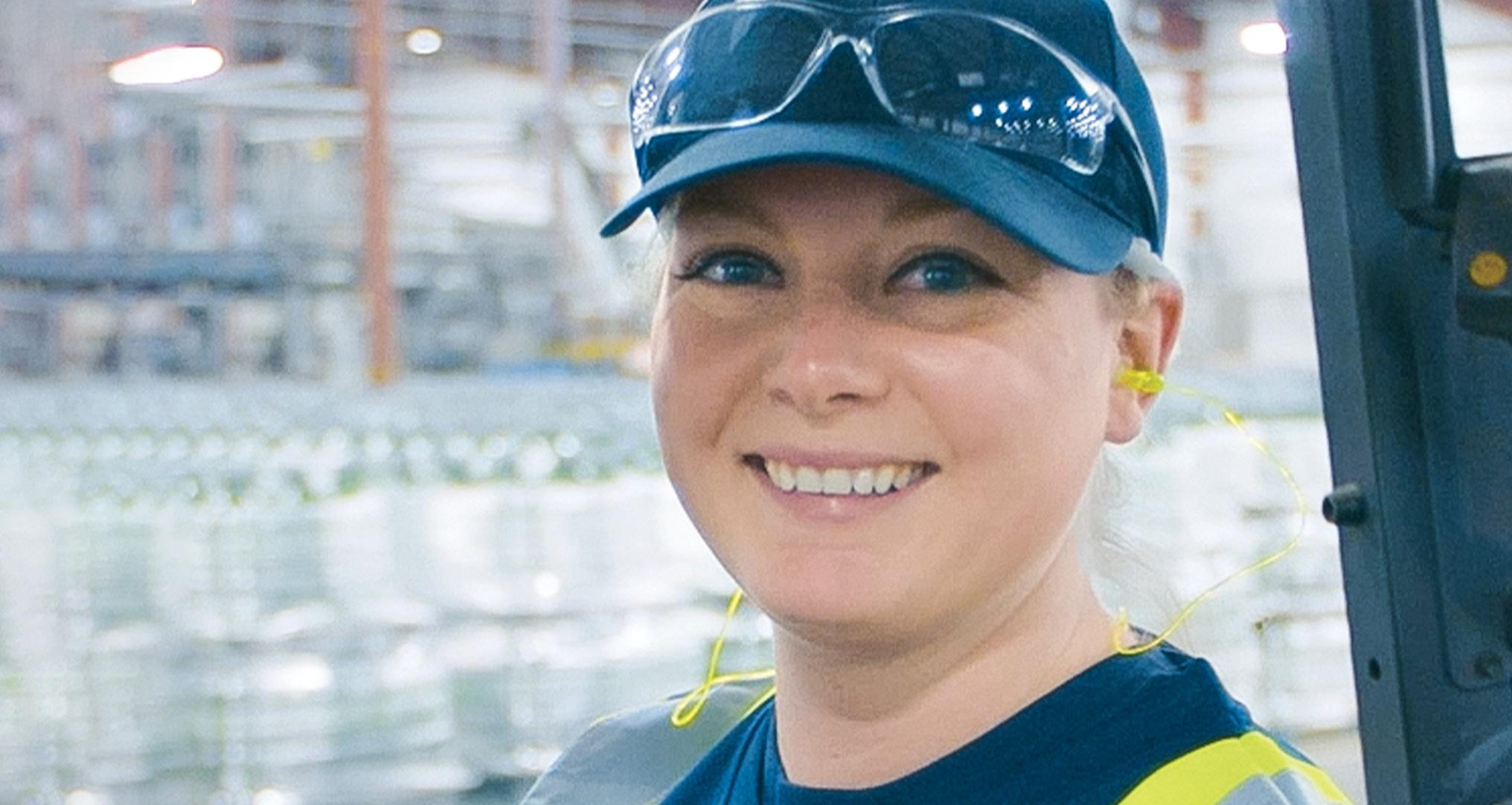
modify equipment and tweak processes in order to push the boundaries of sustainability.
“As owners we want to show that manufacturing can be done in sustainable ways and be successful,” says Gott. “It doesn’t have to cost more to do the right thing for the planet.”
43 CANADA’S GREENEST EMPLOYERS (202 3) PROVIDED CONTENT
Ice River Sustainable Solutions has a strong and dedicated workforce totalling more than 500 employees.
Together, we’re leading the way to a more sustainable future
Geothermal heating/ cooling in buildings Partners with community organizations Green procurement strategy In-house waste reduction and recycling
IKEA Canada brings a holistic vision to sustainability
IKEA Canada also provides customers with information on healthy, sustainable food choices and other lifestyle tips so the experience goes beyond a simple store purchase.
Isabelle Brigliadori’s heart soars when she pulls into the IKEA Canada Calgary store’s parking lot, with its super-efficient watering system, and passes by customers with purchases of new or used furniture made to the highest environmental standards, often helped by her committed co-workers.
Then she enters the goldstandard, energy-efficient building and gets to work to do even more to further the company’s sustainability vision.
“I learned long ago if you don’t work for a company that inspires you inside, it’s just a job versus a
fun place to come every day to work with others,” says Brigliadori, market manager, IKEA Calgary.

“If a company says they’re committed to sustainability, you have to do what you say you’re going to do. IKEA Canada is the first company I’ve worked for that does that 100 per cent of the time.”
A landmark on the home furnishing retail landscape, IKEA Canada has 15 stores that had 26 million customers in 2022, along with another 189 million visiting Ikea.ca. Headquartered in Burlington, Ont., it’s part of the larger IKEA corporate family of companies that operates in 32
countries worldwide.
IKEA’s major sustainability strategy has ambitious targets to meet by 2030. Its three main pillars are healthy and sustainable living, circular and climate positive, and fair and equal. It’s designed to have a big impact on climate change, unsustainable consumption and inequality.
Brigliadori sees the healthy and sustainable living component playing out every day. She says consumers seek out sustainably produced products and appreciate the information IKEA gives them on how their items are manufactured using less water or energy or containing recycled materials.
Supporting the shift towards a circular business, IKEA Canada has a Sell-back program where customers can return their used products for resale for in-store credit. Those items are then sold at reduced prices, increasing affordability. Another program encourages customers to repair their damaged furniture rather than buying a new item.
“We’re assessing all our products and giving them a circularity score to ensure what we bring to the market lives as long as possible and can be passed on or repaired,” says Helene Loberg, country sustainability manager.
“We own our supply chain, so we’re responsible for everything from the very beginning and can make our operations more climate positive and impactful.”
Fairness and equality are also key to IKEA Canada’s strategy, including a commitment to supporting good working conditions in all company
44 CANADA’S GREENEST EMPLOYERS (202 3) PROVIDED CONTENT
IKEA Canada encourages employees to work together as an inclusive business towards its sustainability vision.
Having the vision and commitment to protect this planet on behalf of our future generations is a fantastic way of thinking.
— Isabelle Brigliadori Market Manager, IKEA Calgary
Mattress take-back program at all stores
Sustainability training for employees
Only retails energyefficient light bulbs Forestry standard on origin for wood in products
operations as well as being an inclusive, diverse and welcoming employer. That’s core to getting employees to buy in to the sustainability vision.

“Our co-workers are very motivated to contribute to the sustainability agenda. Our culture is based on values where we work
together as an inclusive business,” says Loberg.
“Every week, co-workers tell me how they feel included and valued at IKEA. That makes so many of us proud to work here.”

IKEA Canada’s sustainability strategy is comprehensive. From big-picture issues like energy and
water reduction to fine details like shifting to selling only rechargeable batteries in stores, the company is working every angle to make an impact.
Brigliadori says IKEA Canada will continue to do more because of its commitment to making the lives of the next generation better.
“The most important people are children because they’re the ones who will have to deal with what we do today,” she says.
“Having the vision and commitment to protect this planet on behalf of our future generations is a fantastic way of thinking.”
45 CANADA’S GREENEST EMPLOYERS (202 3) PROVIDED CONTENT
IKEA Canada provides customers information on how their items are manufactured using less water or energy.
Keilhauer embraces sustainability by design
“Eliminating waste and a robust recycling program can only be successful when everyone participates.”
Constant communication has employees giving feedback on how the company can keep improving. Keilhauer employees create sustainable products in a building incorporating the company’s green values and furthering its environmental goals. From the landscaping planted with native wildflower species providing habitat for bees to a factory floor with LED lighting, Keilhauer’s faculties meet gold standards for energy efficiency and carbon reduction.
Meghan Sherwin loves having a front row seat as Keilhauer Ltd. becomes a global leader in sustainable design and manufacturing – indisputably. When you work for the company that produced the world’s first carbon-neutral office chair, that comes with the job.
“It’s all about our products and making sure what we’re putting into the market is as sustainable as possible,” says Sherwin, chief marketing officer.
“We live and breathe sustainability every day. That makes me proud to work for Keilhauer.”
Keilhauer is a privately-owned furniture manufacturer recognized globally for its
award-winning designs. Founded in 1981, the Toronto-based company manufactures seating and tables for office spaces, government buildings, universities and more.
Keilhauer’s commitment to being a green employer infuses every aspect of the company’s operations. From the design phase to the manufacturing process and post-production of furniture like the pioneering carbon-neutral Swurve chair, Keilhauer takes a holistic approach to ensure its carbon footprint keeps shrinking.
Keilhauer’s Design for the Environment program continually evaluates the environmental impacts of products from the earliest stages. Not only must they be carbon neutral, the company
strives to create products that are 100 per cent recyclable.
Keilhauer’s Take-Back program enables consumers to disassemble and recycle their used furniture. By eliminating single-use packaging for shipping, Keilhauer cut the need for 84,000 boxes in 2019 and over one million since 2000.
One of the keys to the commitment to continuous sustainability is that Keilhauer’s vision has everyone in the company seeing green, from management to the shop floor.
“Our people care about sustainability from top to bottom, from the production lines to the office and company leadership,” says Josh Belczyk, sustainability officer.
— Josh Belczyk Sustainability Officer
The company’s Extended Recycling program not only ensures that waste by-products are reused and repurposed, it builds powerful community connections benefiting many different groups that need a little help from their friends.
Sherwin cites the company’s partnership with the Indigenous Arts Collective of Canada, a not-for-profit organization dedicated to preserving Indigenous art. Keilhauer donates leather remnants from its

46 CANADA’S GREENEST EMPLOYERS (202 3) PROVIDED CONTENT
Keilhauer donated textiles to local charities and community groups.
Our people care about sustainability from top to bottom, from the production lines to the office and company leadership.
manufacturing to the collective’s artists, who in turn create moccasins, leather mittens and other goods for sale to bolster their local economy.

For Sherwin, it’s another example of how a commitment to sustainability can not only benefit the planet, but give people the
means to create useful objects of delight.
“I think that goes back to sustainability being inherent in our culture and our DNA. Any project we undertake, whatever we produce, should be made sustainably. It should always be well made, sustainable and
beautiful,” she says. To keep expanding and refining its sustainability vision, Keilhauer reaches out to community and corporate partners. From the Forest Stewardship Council to the Toronto District School Board, the company seeks out like-minded organizations to reach its goals.

“We pride ourselves on being an organization that is going to be around for the long haul,” says Belczyk.
“The designs we create, the products we produce and the connections we make all help us with sustainability and preserving the planet for people.”
47 CANADA’S GREENEST EMPLOYERS (202 3) PROVIDED CONTENT
A Keilhauer employee working on the construction of a new ottoman.
Design for the Environment program implemented to evaluate products
Created industry’s first carbon-neutral chair, Swurve Extended recycling includes leather
Take-Back program for Tom chairs
At KPMG in Canada, passionate people drive change
can learn about sustainability challenges and how they can respond. Town hall meetings, virtual and in-person events, multimedia communications and other initiatives have explored topics including the impact of fast fashion and protecting pollinators.
Emily Martins says she had only been with KPMG in Canada for a few days in 2019 when some of her new colleagues asked her if she’d like to join the Québec environment committee. They’d heard she shared their passion for bettering the environment and hoped to welcome her aboard.

Martins not only joined the volunteer group, she also became its leader just over a year later –when the pandemic was at its height and limiting environmental activities at the full-service audit, tax and advisory firm.
“The challenges posed by the pandemic required us to reimagine and reinvigorate our
initiatives in order to engage even more of our peers on the journey to green,” says Martins, a Montréal-based manager in strategy within deal advisory.
Since then, the committee has organized lunch-and-learn sessions focusing on sustainability, launched recycling initiatives and created a rooftop garden at the Montréal South Shore office with the support of both KPMG and the building’s landlord. In 2022, they donated 114 kilograms of produce grown in the garden to a local non-profit organization.
For Earth Day 2022, the committee organized a group cleanup along the Lachine Canal. More than 100 KPMG employees came together to pick up 256
kilograms of waste in just two hours.
“It’s empowering that KPMG encourages and supports volunteer opportunities and promotes sustainable practices,” says Martins. “It helps open everyone’s eyes that we all need to do our part to lessen our negative impacts on the planet and help build a more sustainable and resilient future.”
Alongside Québec’s environmental committee, employees across KPMG in Canada’s 40-plus locations participate in a variety of volunteer activities. Participants have planted trees, cleaned up parks and removed invasive plants in local green spaces.
KPMG also ensures its people
Heather Baker, KPMG’s managing partner for quality and risk management and social impact leader, says she was inspired by a session on eco-responsible transportation at the firmwide Earth Day town hall. “I’ve started riding my bicycle to the grocery store more often instead of driving!” she says.
Baker is a member of KPMG’s Our Impact Steering Committee, a multi-disciplinary group of leaders responsible for advancing the firm’s priority environmental, social and governance (ESG) commitments.
In December 2022, KPMG launched a comprehensive ESG report, ‘Our Impact Plan: Canada,’ to outline goals and actions across four key pillars – planet, people, prosperity and governance. Planet
48 CANADA’S GREENEST EMPLOYERS (202 3) PROVIDED CONTENT
Emily Martins, manager in strategy within deal advisory at KPMG, on a trip exploring the Cliffs of Moher, Ireland.
It’s empowering that KPMG encourages and supports volunteer opportunities and promotes sustainable practices.
— Emily Martins Manager, Strategy and Deal Advisory
Committed
emissions by 2030
addresses how KPMG is reducing environmental impact, including progress made toward the firm’s commitment to be a net-zero carbon business by 2030.

As one step on that path, KPMG has implemented an internal carbon price of $40 per metric tonne on the emissions generated
from its business operations, including travel. Baker says the funds will be used to purchase renewable electricity certificates and to invest in new technologies and solutions.
“As a national organization, we have a clear role to play in a just transition to net zero,” Baker says.
“We are setting science-based targets and promoting positive and sustainable change throughout our operations and communities.”
Employees are central to KPMG’s environmental commitments, Baker adds. Martins, for example, is more than an
enthusiastic volunteer. She, and her new co-lead Marion Harvey, share their best practices with other green champions so they can be replicated in other regions – and by KPMG clients.


49 CANADA’S GREENEST EMPLOYERS (202 3) PROVIDED CONTENT
Heather Baker, managing partner for quality and risk management and social impact leader at KPMG, enjoying the outdoors with her dog.
“It’s another way that KPMG lets employees know their input is valued,” Martins says. to achieving net-zero carbon
100% renewable electricity starting in 2022
US $1.5 billion global investment over next 3 years to focus on ESG change agenda
36,422 hours volunteered, including pro bono
Labatt supports sustainable activations
Center,” she says. “We brought in a technology that existed with them and executed it in British Columbia as a pilot. Now other markets globally are looking into rolling it out.”
— Mike Bascom
For Labatt Breweries of Canada there is one brand uniquely placed for championing and piloting environmental initiatives, given its connection to the natural world. “Corona as a brand has always had this deep connection with the outdoors, and that’s why we started our sustainability innovations some years ago,” says Mike Bascom, senior marketing director, Corona Canada.
Since 1925, Corona’s advertising, innovations and activations have encouraged beer drinkers to seek out simple pleasures in places
with a slower pace and a relaxed vibe. “Our spiritual home, our ethos, our core DNA is on the beach,” says Bascom. “In order to enjoy the outdoors, where we believe we all live our best lives, we need to do everything we possibly can to help protect it.”
And Corona has been doing a lot, says Melisa Bayrav, who came on board as senior brand manager in late 2020, as she lists a series of technology-based packaging advancements it has pioneered for Labatt: a low-carbon can pilot in Ontario; the introduction of KeelClip – a state-of-the-art packaging system that eliminated
plastic rings on Corona six-pack beer cans; the Plastic Collecting Billboard erected in the St. Lawrence River in the fall of 2022 for a month; and the innovation that most excites her and Bascom – the Barley Pack.
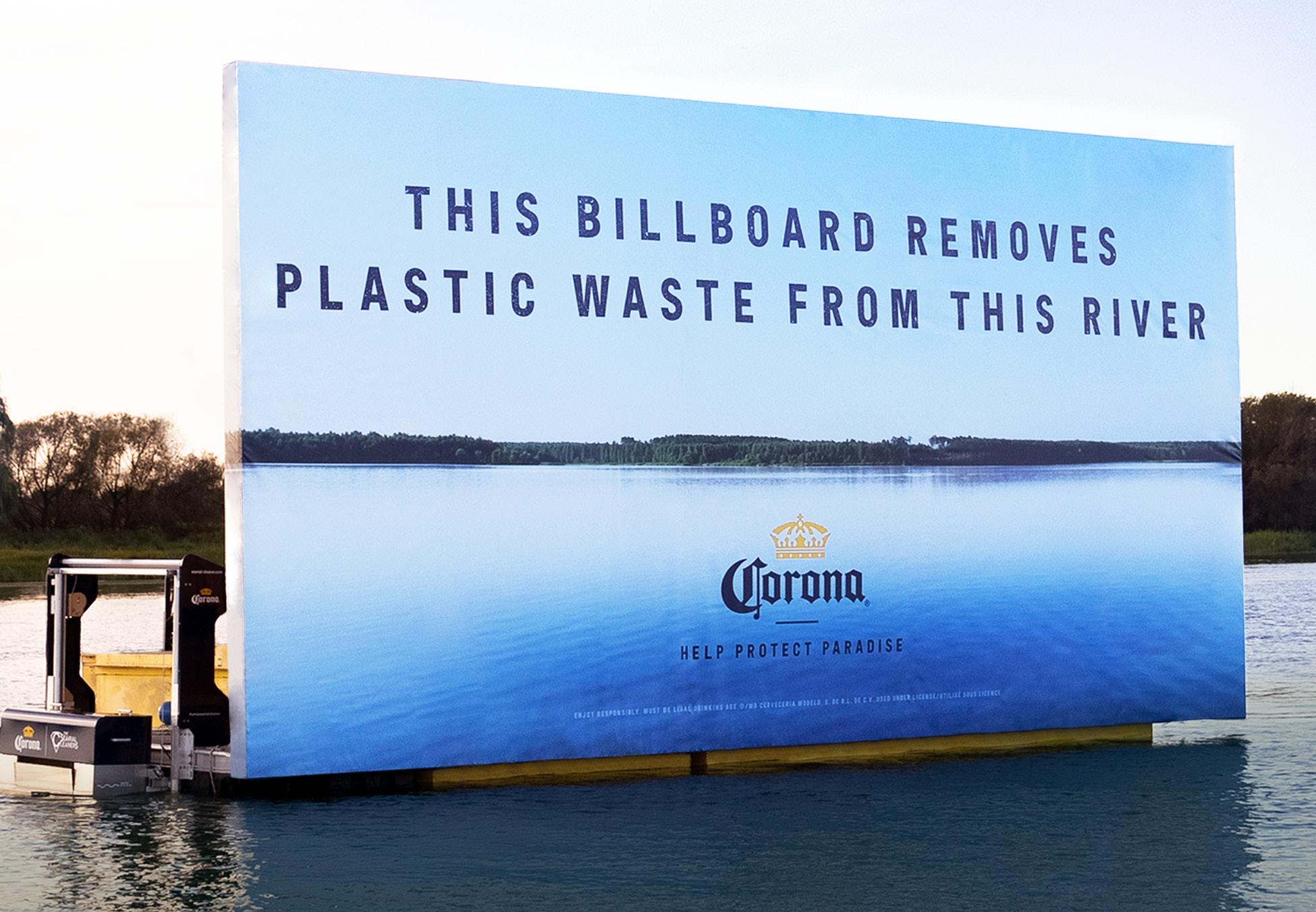
It’s a revolutionary packaging pilot for six-pack beer bottles that uses 30 per cent surplus barley straw and 70 per cent recycled paper fibres to create an innovative cardboard packaging solution.
“The Barley Pack was special because it was in partnership with GITEC, our Belgium-based Global Innovation and Technology
After the KeelClip launch in 2021 in Canada, Bascom explains, Corona took the next logical step. “We took another look at our packaging to see where else we could reduce our impact in Canada. The Barley Pack is a really great innovation, and we were thrilled to be the first global beverage brand to trial it. Barley is a key raw ingredient in the beer itself, so we worked with GITEC to figure out a way to repurpose the leftover barley straw, which typically would be shipped off to be composted.
“Replacing pulp and wood fibre means reducing the number of trees and raw paper used,” Bascom continues, “while switching to barley straw cut the amount of water required by up to 90 per cent.”
The Barley Pack stood up very
50 CANADA’S GREENEST EMPLOYERS (202 3) PROVIDED CONTENT
Labatt Breweries of Canada placed a floating billboard that collected plastic waste from the St. Lawrence River in 2022.
It’s incredible to see how people at Labatt have this desire to go above and beyond to participate and support environmental initiatives.
Senior Marketing Director, Corona Canada
well in the B.C. trial, says the marketing director, and the brand is studying the pilot project results to see if it can be scaled further, as the KeelClip was. “We were first with the clip, and now all of our can brands at Labatt are either in or moving towards it.”
The Labatt commitment to
contributing to sustainability is one leg in a three-legged stool, Bascom says. “It’s consumerdriven, employee-driven and brand-driven. Corona is the most loved beer brand in Canada and we get great pick-up from our consumers when we launch these initiatives – it’s what they’re


looking for.”
Employee passion and commitment are just as evident, says Bayrav. “As brand ambassadors, the team has consciousness and awareness in their everyday lives.”
And that is crucial, Bascom adds. “Many of the ideas behind
these initiatives come from employees. We get people raising their hands from all different functions, not just marketing. It’s incredible to see how people at Labatt have this desire to go above and beyond to participate and to support environmental initiatives.”
51 CANADA’S GREENEST EMPLOYERS (202 3) PROVIDED CONTENT
Corona, a brand of Labatt Breweries of Canada, designed a packaging system that eliminated plastic rings on its six-pack beer cans.
94% recycling rate for industry-standard bottles Green features include kettle heat recovery system Programs to target fleet emissions
Goal to move to 100% renewable electricity
by 2025
Sustainability powers Manitoba Hydro employees
a network of transmission and distribution lines crossing the province, and exports power to other places, it means that the environmental impacts of its business are complex and varied. So the company employs multiple teams of environmental professionals with different expertise areas, she says. “It makes it a really great place to work, and to do meaningful work.”
— Kim
When Manitoba Hydro was constructing its new Keeyask hydroelectric generating station more than 700 kilometres north of Winnipeg, workers ran into a problem: the area’s native gulls and terns liked to nest and lay their eggs close to the water, where construction was ongoing.
“It became a hazard for the workers and the birds because you
can’t have nests there,” recalls Kim Bryson, an environmental specialist in Manitoba Hydro’s enterprise environment department who led a team of environmental inspectors at Keeyask.
So the company found a creative solution: it hired a falconry outfit that flew falcons and other birds of prey around the control zone to keep smaller birds away from the site – and out of harm’s way.
Bryson says that solution, and
much of her team’s work – which involves ensuring environmental protection plans are being followed and offering education and advice when unanticipated challenges arise – exemplifies Manitoba Hydro’s approach to caring for the environment.

“I respect and appreciate how fully integrated environmental considerations are in all aspects of our business,” she says. Bryson notes that since the utility generates hydroelectric power, has
Dave Little, the utility’s director of health, safety and environment, says the company has been embedding environmental stewardship into all aspects of its business for decades. When building at new sites, that means leaving the area in a good condition or better than the company found it. It also means running operations such as a fish hatchery in Grand Rapids, where one of the company’s environmental teams rears walleye and sturgeon and then returns the fish to their native waterways to boost populations in the area.
And nearly 20 years ago, when it started building its head office in Winnipeg, it meant designing the location with the aims of getting a
52 CANADA’S GREENEST EMPLOYERS (202 3) PROVIDED CONTENT
The head office at Manitoba Hydro has several rooftop gardens including one for Indigenous plants.
I respect and appreciate how fully integrated environmental considerations are in all aspects of our business.
Bryson Environmental Specialist, Enterprise Environment Department
LEED certification, an unconventional move at the time.
“We didn’t have to go for LEED but the decision was, we need to move in that direction and show people we were willing to put our money where our mouth is,” says Little, who was the construction lead on the building.
Today, the building is a source of pride for the company and employees, with a 70 per cent lower energy footprint than comparable office towers, a Platinum LEED certification, shower facilities on-site to encourage active transportation to work and green roofs on the third
floor. The green roofs hold an apiary and a garden of plants traditionally used by Indigenous Peoples. “You can get your hands in the dirt on your break,” Bryson says.
Over the past few years, when droughts have led to a shortage in sage – something used in


Indigenous medicines – Bryson says Manitoba Hydro donated the bumper crop from its roof gardens to local Indigenous community groups.
“Things like that speak to the culture here, and just jibe with my morals and ethics,” she says. “It’s really something special.”

53 CANADA’S GREENEST EMPLOYERS (202 3) PROVIDED CONTENT
www.hydro.mb.ca | Available in accessible formats upon request ECO-CONSCIOUS SUSTAINABLE DEVELOPMENT RENEWABLE ENERGY CLEAN-BURNING NATURAL GAS WILDLIFE STEWARDSHIP ENVIRONMENTAL LEADERSHIP PROUD TO BE ONE OF CANADA'S GREENEST EMPLOYERS
A Manitoba Hydro employee monitoring fish movement near one of its generating stations.
In-house and external environmental auditing Green procurement strategy
Formal green strategy
Informal employee-led green initiatives
Medtronic commits to a greener health-care industry
vision for it; the response was that it should be environmentally friendly.
Other initiatives include asking customers to return end-of-life devices such as pacemakers and defibrillators to Medtronic. Considered hazardous waste, they were being safely stored in the warehouse. Medtronic created a process to collect and disinfect the devices, then properly dispose of any recyclable parts, such as batteries and precious metals.
In 2014, when Cameron Hawn joined Brampton, Ont.-based Medtronic Canada ULC as a territory manager for Central Canada, there weren’t many discussions about sustainability in the medical sales industry. Today, it’s a completely different story –in fact, Medtronic’s customers are asking him what the company is doing to advance sustainable practices and processes.
Medtronic researches, designs, manufactures and sells medical devices and therapies. “The feedback I receive from hospitals is that they’re looking for partners, not just suppliers,” says Hawn, now manager of strategic partnerships. “Unlike a decade

ago, it’s no longer the case of needing a medical device, but they want to know where it’s coming from and how it’s made.”
Medtronic has a long history of doing the right thing for customers and patients. “We’re purpose-driven relative to our mission to maintain good citizenship as a company, and that includes our social responsibility,” says President Sheri Dodd, who joined Medtronic Canada in the fall of 2022. “The company’s commitment – and the employees’ drive to sustainability in Canada – are very impressive.”
That sense of stewardship led Medtronic to become a co-founding member of the
Canadian Coalition for Green Health Care, which is working toward an environmentally sustainable, climate resilient and net-zero health system. Medtronic also has internal environmental action groups across Canada, where employees can share best practices and contribute suggestions on how to be greener.
One of the most impressive initiatives is the Brampton head office, which opened in 2009 with a Leadership in Energy Efficiency and Design (LEED) silver designation. In fact, the headquarters was the first Medtronic office globally to go green. Before it was built, employees were asked about their
“Environmental awareness is becoming part of more and more conversations,” says Hawn. “We’re creating a more sustainable ecosystem beyond solving product challenges, and we’re looking at challenges related to patient outcomes, staffing and operating room efficiencies.” This also includes extending the shelf life of innovative technologies, resulting in less clinical and residual waste. Smaller but still impactful steps include encouraging employees to take coffee grounds from the cafeteria to use as compost in their gardens and to plant tree seedlings at home. There’s a charging station for electric cars in the
54 CANADA’S GREENEST EMPLOYERS (202 3) PROVIDED CONTENT
Cameron Hawn, manager, strategic partnerships of Medtronic Canada, enjoying a bike ride with his son.
There are so many great team members and customers who care about sustainability –it’s a huge collaboration.
— Cameron Hawn Manager, Strategic Partnerships
company’s parking lot and incentives for leasing hybrid company cars. In 2021, the Canadian offices went paperless for invoicing, the first country within Medtronic to do so.
“There are so many great team members and customers who care about sustainability – it’s a huge

collaboration,” says Hawn. “It’s no longer good enough to be good enough. We’re pushing the envelope to provide an exceptional experience for patients, hospitals and our employees.”
In her off time, Dodd says, she and her husband love to hike, ski and snowshoe. “My joy is being
outside, and I want the environment to be healthy for a long time,” she says. “I bring that mentality to how I operate in my work – and I love that I found a company that shares those values.”
When a hospital partners with Medtronic, they’re getting a

company that’s committed to green – and while Dodd is proud of their environmental strides, they’re committed to doing more.
“We can touch thousands of hospitals, then multiply that by hundreds of products and tens of thousands of patients,” she says.
“That’s good math.”
55 CANADA’S GREENEST EMPLOYERS (202 3) PROVIDED CONTENT
Sheri Dodd, president at Medtronic Canada, enjoying the harvest from her own garden.
In-house waste reduction and recycling Green procurement strategy
Established carbon reduction targets Publishes sustainability report
PCL’s size encourages sustainable industry
PCL’s part in a massive project to transition existing, federally owned infrastructure to help Ottawa achieve its 2030 climate goals. “That is going to be very impactful,” says Wieninger – who, like PCL’s three other COOs, works closely with the company’s Denver-based director of sustainability – “given the expectations, the timeline and the extensive number of buildings involved. So I think that’s where PCL’s leadership role will really be quite impactful.”
us.
When he joined PCL Construction
26 years ago, says Mike Wieninger, chief operating officer, Canadian operations, the push for a greener industry was already culturally ingrained in his company. “But that has accelerated markedly in the last four or five years as we’ve put more rigour,
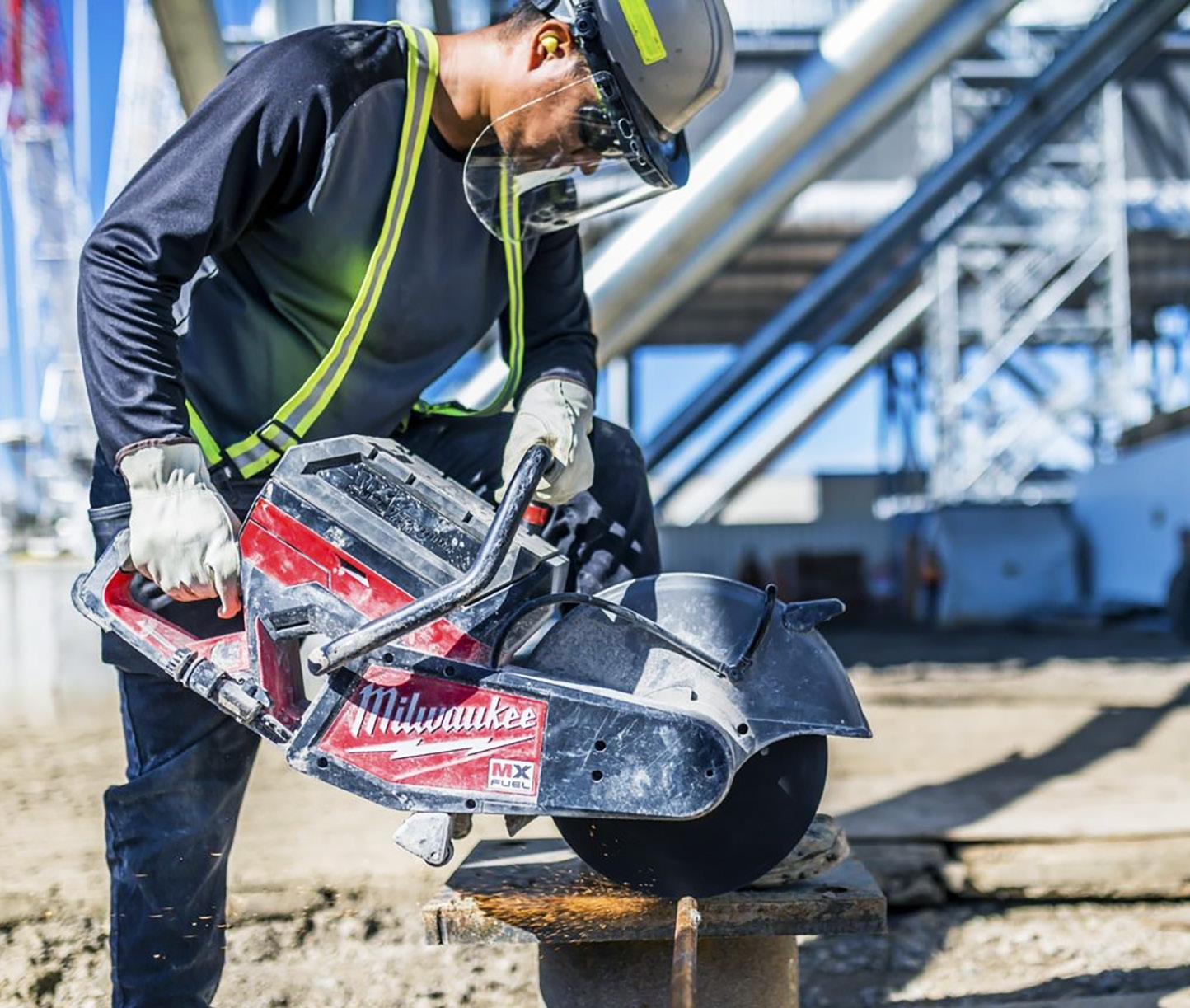
more emphasis on sustainability,” he says.
“That really matters a lot to PCL people, of whatever generation. A question we hear a lot from young professionals, who all have a green mindset, coming into our industry is, ‘What are you doing about sustainability?’ So we walk through those things,” says Wieninger. And there’s a lot to go through, adds the COO, including the $2.8
billion in solar projects PCL has recently built. “We started producing those in Ontario, then moved it across Canada into the United States, and now in Australia,” Wieninger says. “We just finished a solar farm here in Alberta, at Travers, that will power 100,000 homes annually. At five kilometres by six kilometres, it’s huge, the largest ever in Canada.“
Even that pales in comparison to
That’s because construction giant PCL is, in ecological terms, a keystone species – large enough and influential enough to alter the way an industry functions. “We have lots of conversations upstream in our supply chain,” says Scott Sharun, senior manager, procurement and equipment, with PCL’s Edmonton industrial office. “If companies like PCL aren’t pushing for sustainability, then our vendors don’t feel pressure because the small and mid-size folks aren’t going to get much traction in that regard.
56 CANADA’S GREENEST EMPLOYERS (202 3) PROVIDED CONTENT
PCL Construction works with suppliers to find ways to reduce carbon footprint during construction.
When you find the right suppliers with the right people, the push comes from them and the pull comes from
— Scott Sharun Senior Manager, Procurement and Equipment
20
$500M+ in biofuel and biogas projects delivered
“Having the biggest construction company in Canada say to a large multinational, ‘I can't use your products because they cost too much to ship or we have to throw away all the packaging they come wrapped in,’ that has an effect,” Sharun says. “We are aware of it, and where we see opportunity,

we’ve definitely pushed for it 100 per cent.”
But it’s a two-way street, Sharun emphasizes. “A lot of the manufacturing companies are already getting there,” he says.
“That’s what makes the supply chain a doorway for innovations for a company like PCL. For
example, on project sites, exhaust is a real concern, and we've been doing what we can to mitigate it. “A strategic partner and supplier asked, ‘Do you really believe there are going to be gas engines or even electrical cords on your site in the next five to 10 years? What are you waiting for?’” continues Sharun.
“PCL is always thinking about what’s ahead for our industry. It was clear to both of us that the future of construction will be electric and battery powered. When you find the right suppliers with the right people, the push comes from them and the pull comes from us.”
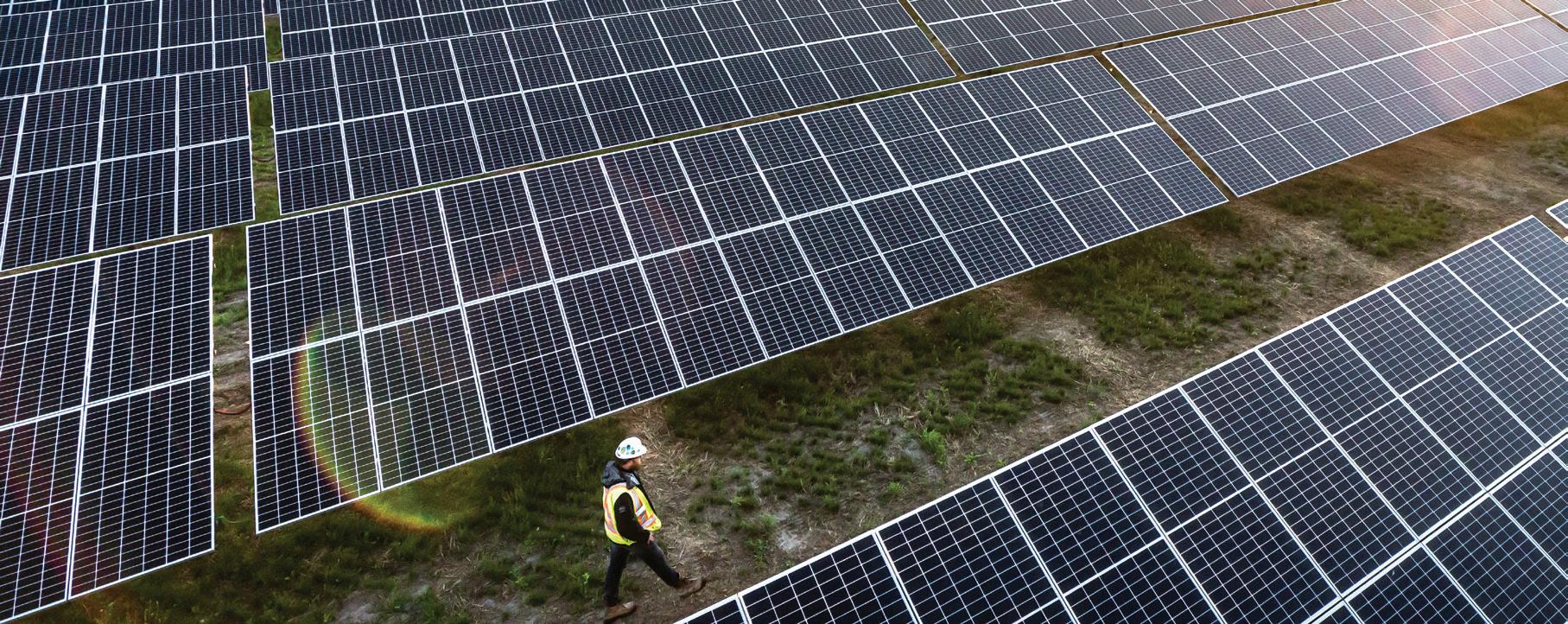
57 CANADA’S GREENEST EMPLOYERS (202 3) PROVIDED CONTENT
PCL Construction employees volunteering at a river cleanup.
pcl.com/careers
$3 billion in completed renewable energy projects
billion gallons of water treated daily by PCL projects
On track to solarpower 500,000 homes & businesses in Canada, U.S., Australia
RONA employee engagement is key to sustainability
building a better world for future generations.”
New measures that were implemented over the past year include creating an employee engagement initiative in stores across the country called the ECO Squad.
Keven Rousseau had achieved his master’s degree in environmental management and worked with some small enterprises when, two years ago, he was looking for an opportunity to have a greater impact.
“At RONA there is executive buy-in,” says Rousseau, who became advisor, sustainable development, at the company. “It helps us to be bold in what we suggest. Not every senior leader would have championed some of our team’s innovative projects.”
From its head office in the Greater Montréal area, RONA operates and services a network of
some 450 corporate and affiliated dealer stores from coast to coast under the Lowe’s, RONA, Réno-Dépôt and Dick’s Lumber banners. Combined with the company’s online channels, these stores have been meeting the needs of Canada's home improvement DIYers and contractors alike since 1939.
RONA’s sustainability strategy relies on three pillars: to help customers reduce their environmental footprint, to reduce the environmental impact of RONA’s operations, and to support employees and communities.
“Moved by the desire to be a leader in sustainability, RONA stopped offering single-use plastic
shopping bags at all its locations in 2022, a first in the home improvement retail sector,” says Mélanie Lussier, director, external communications and sustainable development.

In 2022, RONA also received the Fédération des chambres de commerce du Québec’s Sustainable Development Strategy Mercure award, which recognized the company’s achievements in improving the energy efficiency of its buildings.
“Every year we initiate new projects and take on new measures for the environment,” says Lussier. “It’s important for us that we continue to improve how we do things and to contribute to
At RONA, engaging employees in the organization’s sustainability initiatives is key to driving meaningful change and results.
“When we collaborate with stores on a project, there is an overall willingness to help. People genuinely care about doing the right thing and improving how we operate from an environmental standpoint,” says Rousseau.
The new ECO Squad plays a big part in store engagement. It was important for Rousseau that members of the squad in each store volunteered for the role –
58 CANADA’S GREENEST EMPLOYERS (202 3) PROVIDED CONTENT
Mélanie Lussier, director, external communications and sustainable development, and Keven Rousseau, advisor, sustainable development, at RONA inc
Our sustainability strategy and initiatives differentiate us from other companies, and we clearly see that people want to work and shop with companies that have the same values they do.
— Mélanie Lussier Director, External Communications and Sustainable Development
members
$16,000 donated to environmental charities each year
3,200 tons of endof-life materials diverted each year
5,000 ECO products available in stores and online

and their enthusiasm shows, he says. Each month, he meets virtually with them to talk about sustainability, sharing information on policies and procedures, as well as best practices. The ECO Squad has been instrumental in moving the new waste management project forward.
Last year, in order to send the least possible waste to landfill, RONA launched a program to track waste management performance in stores and implemented an incentives program. Each quarter, the store with the best diversion rate and the store with the biggest rate
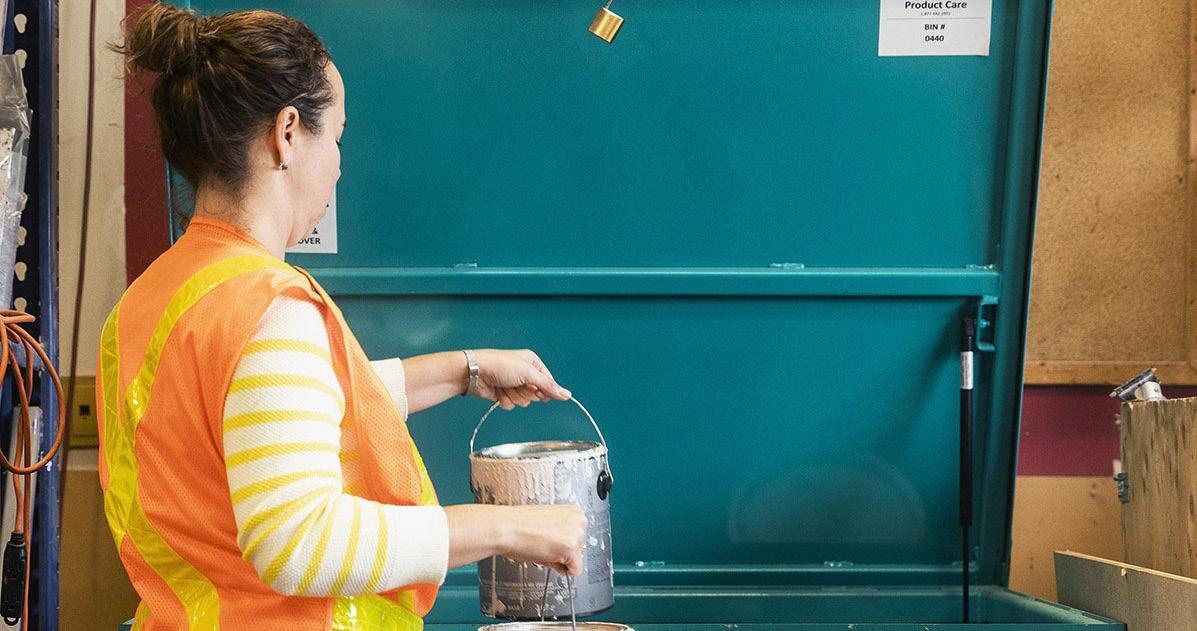
increase, in the east and the west, is awarded a prize of $1,000 to give to a local environmental charity – for a total of four stores each quarter. As a thank you to the winning stores’ teams, 10 gift cards are also drawn among employees.
“RONA’s success in achieving sustainability targets hinges on
spreading the culture of sustainability to its employees,” says Lussier. “Our sustainability strategy and initiatives differentiate us from other companies, and we clearly see that people want to work and shop with companies that have the same values they do.”
59 CANADA’S GREENEST EMPLOYERS (202 3) PROVIDED CONTENT
The take-back program at RONA helps divert 3,200 tons of end-of-life materials each year.
230 ECO Squad
SaskTel employees take pride in protecting their home
requirements and deliver on its environmental strategy.
“Through our EMS, we aim to reduce our environmental impact, the resources used and the waste generated,” says Shara McCormick, vice-president, human resources and corporate services. “We are focused on waste minimization, fuel and energy use efficiency, reducing overall direct greenhouse gas emissions, biosecurity and supporting employee-driven community greening initiatives through our EnviroCare team.”
In 2022, SaskTel affirmed its commitment to environmental sustainability by adding it as a new area of focus when deciding which non-profit organizations its Community Investment Program (CIP) will support.
Since 2001, SaskTel has supported non-profit and charitable organizations that concentrate on areas including information and communications technology, women in nontraditional roles, persons with disabilities, visible minorities, youth, Indigenous people and
rural communities. It has now added events and programs that feature environmental sustainability.
Greg Hern, human resources manager, environment, says it just makes sense to support environmental sustainability, whether through CIP or the many other ways SaskTel embeds a green mindset into its operations.

“It seems like it’s a requirement socially right now, but it’s more than that,” he says. “This is our home. This is where we live. We see ourselves as leaders in the environmental field in
Saskatchewan. We are always paying attention and trying to do what we can with the resources we have.”
An example is SaskTel’s environmental management system (EMS). Aligned with ISO 14001, the international standard that specifies requirements for an effective EMS, SaskTel’s system is a group of interrelated policies and procedures that help the organization control its impact on the environment. SaskTel uses the EMS to monitor day-to-day operational processes, ensure alignment with legislative
SaskTel’s EnviroCare volunteer group works to create a greener community and promote environmental awareness. This includes hosting lunch-andlearns, co-ordinating donation drives and doing cleanups and plantings at local parks and greenspaces.
The SaskTel Phones for a Fresh Start program collects and recycles old cellphones and directs all the proceeds to buy and donate newer phones and prepaid phone cards to support those fleeing domestic
60 CANADA’S GREENEST EMPLOYERS (202 3) PROVIDED CONTENT
Greg Hern, human resources manager, environment, at SaskTel
We see ourselves as leaders in the environmental field in Saskatchewan. We are always paying attention and trying to do what we can with the resources we have.
— Greg Hern Human Resources Manager, Environment
violence and youth transitioning out of care from the Ministry of Social Services. In 2021-22, Phones for a Fresh Start provided 675 phones and $12,000 worth of phone cards. The program recycled 5,363 devices.
“People go through phones quite quickly now,” says Hern. “So we
use the value of those devices through the recycling and refurbishment process to support an important cause and to help the environment.”
SaskTel has other e-waste recycling initiatives as well. The SaskTel Pioneers, a network of current and retired employee

volunteers, refurbish used computers and donate them to schools. SaskTel also recycles or repurposes consumer electronic equipment and gadgets, as well as its own equipment, such as cable boxes and telecom servers.
Hern says all of these initiatives and the commitment to
sustainability is a source of pride for employees. “We get a lot of input and questions from employees who are really passionate about protecting the environment,” he says. “We are proud of Saskatchewan and are very interested in protecting our home and doing what we can.”


61 CANADA’S GREENEST EMPLOYERS (202 3) PROVIDED CONTENT
Committed to the environment.
A SaskTel employee volunteering to clean the community and promote environmental awareness.
sasktel.com/careers
Paperless contracts and e-billing for customers
In-house and external environmental audit
Extended recycling includes wire and cabling
SaskTel EnviroCare employee green team
Siemens’ sharing multiplies its sustainability impact
decarbonization, ethics, governance, resource efficiency, equity and employability.
“There is a lot of transformation going on and we want to ensure that we’re investing enough in the education of our employees,” says Kazi.
Employees are involved in sustainability initiatives through their work and through the green culture that extends to extracurricular projects. Every year, Siemens Canada holds tree-planting events across the country, including near its head office in Oakville, Ont.
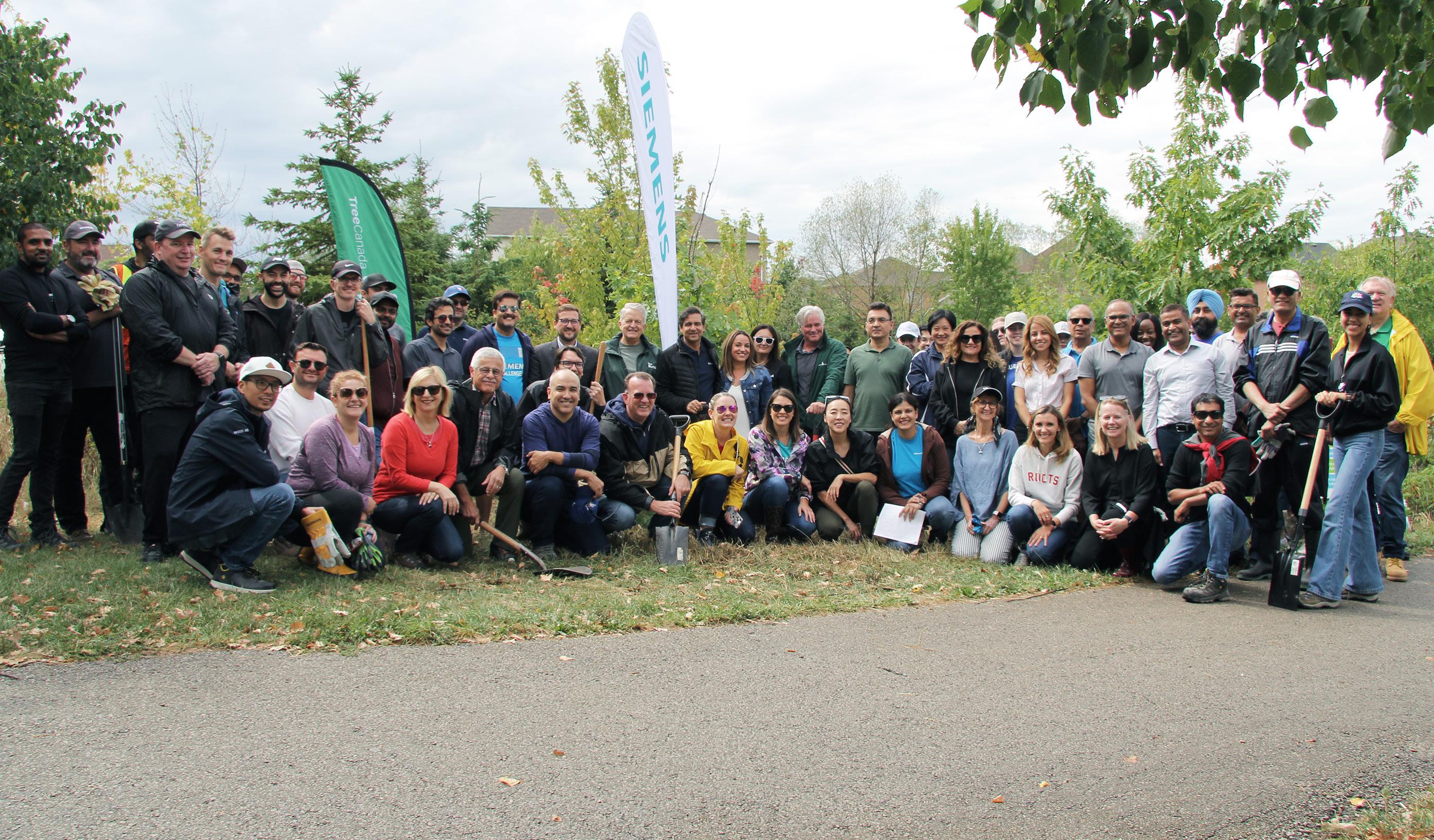
Amy Geisberger joined Siemens Canada Limited last year as sustainability manager. Right away she noticed her colleagues showed a keen interest in her work.
“I’ve been invited to speak at so many team meetings,” says Geisberger. “Everyone is open to learning more about sustainability and how they can help in their functions.”
At Siemens Canada, some 2,900 employees deliver solutions for sustainable energy management, smart infrastructure and efficient manufacturing. The company creates technology for more resource-efficient factories, resilient supply chains, smarter buildings and grids, and cleaner sustainable transportation.
“Siemens has a strong track record as a leader in sustainability,” says Faisal Kazi, president and CEO. “We were one of the first to commit to net zero by 2030. And we have a very large footprint –not just our offices, but factories and more.”
Since 2019, Siemens has reduced carbon dioxide emissions in its global operations by approximately 46 per cent. And Siemens spends approximately 5 billion euros (over $7 billion) globally on research and development each year to generate new inventions that create technology with purpose.
Geisberger works with two teams in her role as sustainability manager. One team works to further improve emissions reduction at Siemens Canada. The
second team works with customers to use Siemens’ innovative technology to help with their decarbonization and sustainability goals.
“This is how we multiply our impact on the environment,” says Geisberger. “We use our technology and expertise – and we share it.”
In past roles, Geisberger spent much of her time educating senior leaders on sustainability. “I was shocked when I came here,” she says. “At Siemens we have so much information available.”
There are live webinars led by internal and external experts, and e-learning modules, including a program called Sustainability at Siemens: Base Camp that explains its DEGREE strategic framework with six fields of action:
Over the past decade, company employees and partners have planted nearly 15,000 trees.
Another recent pilot project was to install a Smartflower micro-grid that moves with the sun throughout the day to provide efficient solar power to aspects of the head office. It’s a living lab where employees can see results
62 CANADA’S GREENEST EMPLOYERS (202 3) PROVIDED CONTENT
Siemens Canada employees volunteering for its annual tree planting activity.
It’s not just that the company is an environmental champion. Siemens gives employees the opportunity to make an impact on the environment through our innovative sustainability solutions.
— Faisal Kazi President and CEO
in a display at the entrance to the building. A Smartflower micro-grid is also powering classrooms and providing educational, real-time data on electricity production and energy absorption in a high school in Saskatoon.

Employees also support the
donation of the company’s used laptops, which means they haven’t ended up in landfills since 2010. Replaced every three years, the laptops must be wiped of data and cleaned to be repurposed for new recipients, which would be a significant expenditure for the company. Instead, employees
volunteer to take on the work, and the computers have gone to everyone from Indigenous communities to students studying at home during the pandemic, to newcomers from Ukraine who had the computers set up in their native language.
These are just a few of the many
Technology with purpose
green initiatives Siemens employees can get involved in. “It’s not just that the company is an environmental champion,” says Kazi. “Siemens gives employees the opportunity to make an impact on the environment through our innovative sustainability solutions.”
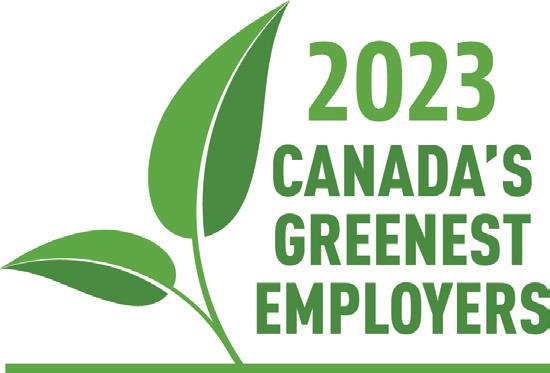

63 CANADA’S GREENEST EMPLOYERS (202 3) PROVIDED CONTENT
A ground-mounted solar system generates power at the Siemens Canada headquarters in Oakville, Ontario.
Create a more sustainable #TomorrowWithUs Discover
Formal greenhouse gas emission reduction targets
Personal spending account covers transit passes Energy-efficient building automation controls Clean supply chain initiative
Sleeman Breweries grows environmental awareness
distributors; continuing to encourage a 3R mindset of reduce, reuse and recycle; and sustaining the natural environment through employee and community engagement.
Examples of that third pillar include events planned each spring around Earth Day and each October around Waste Reduction Week. It also includes celebrating individual “green champions” –employees who are incorporating sustainable practices such as composting and recycling into their lives away from work.
As Canada’s third-largest national brewer, Sleeman Breweries Ltd. produces some of the most popular beer in the country. But for Sleeman employees, striving for excellence isn’t just about delivering Canadians better beer, it’s also about doing so as sustainably as possible.

At breweries stretching from Chambly, Que., to Vernon, B.C., employees who are passionate about sustainability volunteer to be part of “green teams” that look for opportunities to improve environmental performance. Every month, team leads from the
breweries and distribution centres meet as a national green team to share best practices.
“Our working motto is ‘growing our environmental awareness,’” says Linden Gossen, Sleeman’s national environmental health and safety manager who leads the national green team from the company’s head office in Guelph, Ont. “Our goal is continuous improvement, and key to that is effective communication and employee engagement.”
A good example is Sleeman’s successful effort in recent years to improve its landfill diversion rate from about 60 per cent to a remarkable 97 per cent.
“Some of that was a top-down
effort to provide readily accessible and well-marked receptacles as well as conducting waste audits and reporting on the results,” says Gossen. “But mostly, it’s about building awareness of what can be done and then seeing the uptake from our employees.”
Another employee-driven initiative during the pandemic resulted in the company finding a vendor to recycle disposable masks.
In 2022, Sleeman consolidated its sustainability strategies into a new environmental policy framework with three key pillars. They are: reducing the carbon footprint of its breweries as well as that of its suppliers and
Because 95 per cent of beer comes from water, reducing water consumption is an obvious priority. In 2019, the City of Guelph recognized water conservation efforts at the local Sleeman brewery, where upgraded equipment and modified brewing processes resulted in water savings of 298,000 litres (or over 5,000 kegs) every day.
The Guelph brewery also treats 100 per cent of its effluent waste streams on site, thereby minimizing the load on municipal wastewater systems.
Distribution is a big part of Sleeman’s extended operations,
64 CANADA’S GREENEST EMPLOYERS (202 3) PROVIDED CONTENT
Sleeman Breweries upgraded its equipment and modified brewing processes that resulted in water savings of 298,000 litres every day.
People have a lot of choices these days and one of them is to choose to be with a company that aligns with their values.
— Martin Durocher Vice President, Human Resources
Environmental policy
National and regional green teams
Celebrates environmental champions
Recycling COVIDrelated masks and other PPE
and recently introduced delivery routing software has proven to be both cost-effective and more energy-efficient.
Sustainability is one of three cornerstones of the social responsibility model that Martin Durocher, vice president of human resources, is helping to
build for the company (the other two are community engagement and diversity, equity and inclusion).
“We are focusing our sustainability efforts where we can have the most impact, water being a big one,” says Durocher. “We are also trying to be more transparent
about how we do that, weaving information into our job postings, our website and our social media presence.”

In a highly competitive job market, adds Durocher, a commitment to sustainability is one way a company like Sleeman can stand out.
“We are noticing that environmental performance is something many job candidates and current employees really care about,” he says. “People have a lot of choices these days and one of them is to choose to be with a company that aligns with their values.”

65 CANADA’S GREENEST EMPLOYERS (202 3) PROVIDED CONTENT
Sleeman Breweries recently introduced delivery routing software that contributes to more energy-efficient distribution.
Caring for the planet is part of the culture at TD
more than 28,000 local environmental projects. This commitment is present in the TD culture, where colleagues are encouraged to participate in activities such as TD Tree Days, an initiative that has resulted in more than 435,000 trees being planted since 2010.
When Huma Pabani went camping as a Girl Guide, she was taught to leave campsites the way she found them so everyone could enjoy the beautiful natural space. This environmental-stewardship lesson shaped her thinking as an adult – and she feels fortunate to put her passion for sustainability to work at Toronto-based TD Bank Group.

At TD, the environmental, social and governance (ESG) strategy reflects the Bank’s commitments
in this space, and shows in the actions it takes to drive progress.
“We know climate change is posing a risk to our planet, and we need to act urgently,” says Pabani, senior manager, environment and national issues, at TD Insurance.
“It’s wonderful to work on ESG at a leading Canadian bank, where there’s a real desire to do meaningful, impactful work.”
In 2020, TD released its Climate Action Plan and became the first major bank in Canada to announce a target to achieve net-zero greenhouse gas (GHG) emissions by 2050 across its
operations and financing, in alignment with the principles of the 2015 Paris Climate Agreement. “While it’s a daunting goal, it’s very exciting to be part of the work to achieve this,” says Pabani. “We’re looking at our operations, supply chain and customer interactions to identify and address opportunities to reduce emissions.”
Since 1990, the TD Friends of the Environment Foundation has driven forward the Bank’s commitment to achieve growth while protecting the planet by providing over $100 million to
In 2019, Pabani attended training in Minneapolis as part of former U.S. vice-president Al Gore’s Climate Reality Project, which trains people to become change-makers working toward climate solutions. “This work is a learning process,” she says. “It can be overwhelming at times, but we believe in the work, and there are many achievements we can celebrate along the way.”
Noah Brito, associate vice president of enterprise decarbonization strategy, is helping TD continuously evolve and implement its Climate Action Plan. “Our stakeholders have been asking for accountability around carbon emissions in the finance industry,” he says. “TD has always done a lot of good in this space, but there’s an increased focus now, so we created a Climate Action Plan roadmap and an entire team
66 CANADA’S GREENEST EMPLOYERS (202 3) PROVIDED CONTENT
TD has always done a lot of good in this space, but there’s an increased focus now.
— Noah Brito Associate Vice President, Enterprise Decarbonization Strategy
Huma Pabani, senior manager, environment and national issues, at TD Bank
In-house
to do this work.”
The 2050 net-zero goal is challenging, and TD must first account for both its operational and finance emissions. “It’s a multi-year journey that requires overcoming data challenges, along with internal and external collaboration, such as working with
bodies like the Partnership for Carbon Accounting Financials and the Net Zero Banking Alliance,” says Brito. “We’re looking at science to tell us how to get to net zero so we can figure out where to focus our efforts.”

Brito has led the first 2030 financed emissions targets at TD.
“Setting these targets is one of the first steps forward and achieving them will give me a great sense of accomplishment. But the work doesn't stop there – we all need to keep moving forward one step at a time.” “In 2050, I'll be 61 and I hope to see us achieve our net-zero target by then because
that will mean the economy has moved in the right direction to fight climate change.”
Starting in April, Huma, Noah and TD employees across Canada will celebrate Earth Day, Earth Month and other initiatives that contribute to a more vibrant planet and greener tomorrow for all.

67 CANADA’S GREENEST EMPLOYERS (202 3) PROVIDED CONTENT
Noah Brito, associate vice president, enterprise decarbonization strategy, at TD Bank.
TD is proud to be one of Canada’s Greenest Employers. jobs.td.com
Building footprints include EV charging stations
experts to address a low-carbon economy
New environmentally focused mutual funds Earth Week includes tree-planting initiatives
TELUS innovates with 5G to revolutionize forestry
see how we can help,” says Mackay. “It’s important for us to learn and uncover what 5G connectivity and drone technology can do for nature.
As a British Columbian, Rachel Mackay has seen firsthand the effects of climate change with things such as wildfires and deforestation. “I’m an avid outdoor recreational enthusiast,” says Mackay, manager, business development, environment, for Vancouver-based TELUS Communications Inc. “Living in an area where forests are a big part of my life, it’s inspiring that I get to work in this space.”
Mackay leads business development and strategy enablement on the company’s environmental solutions team,
working on initiatives to build solutions for protecting and enhancing nature.
“Right now, our team is focused on nature-based carbon solutions, so utilizing nature to help mitigate climate change,” says Mackay.
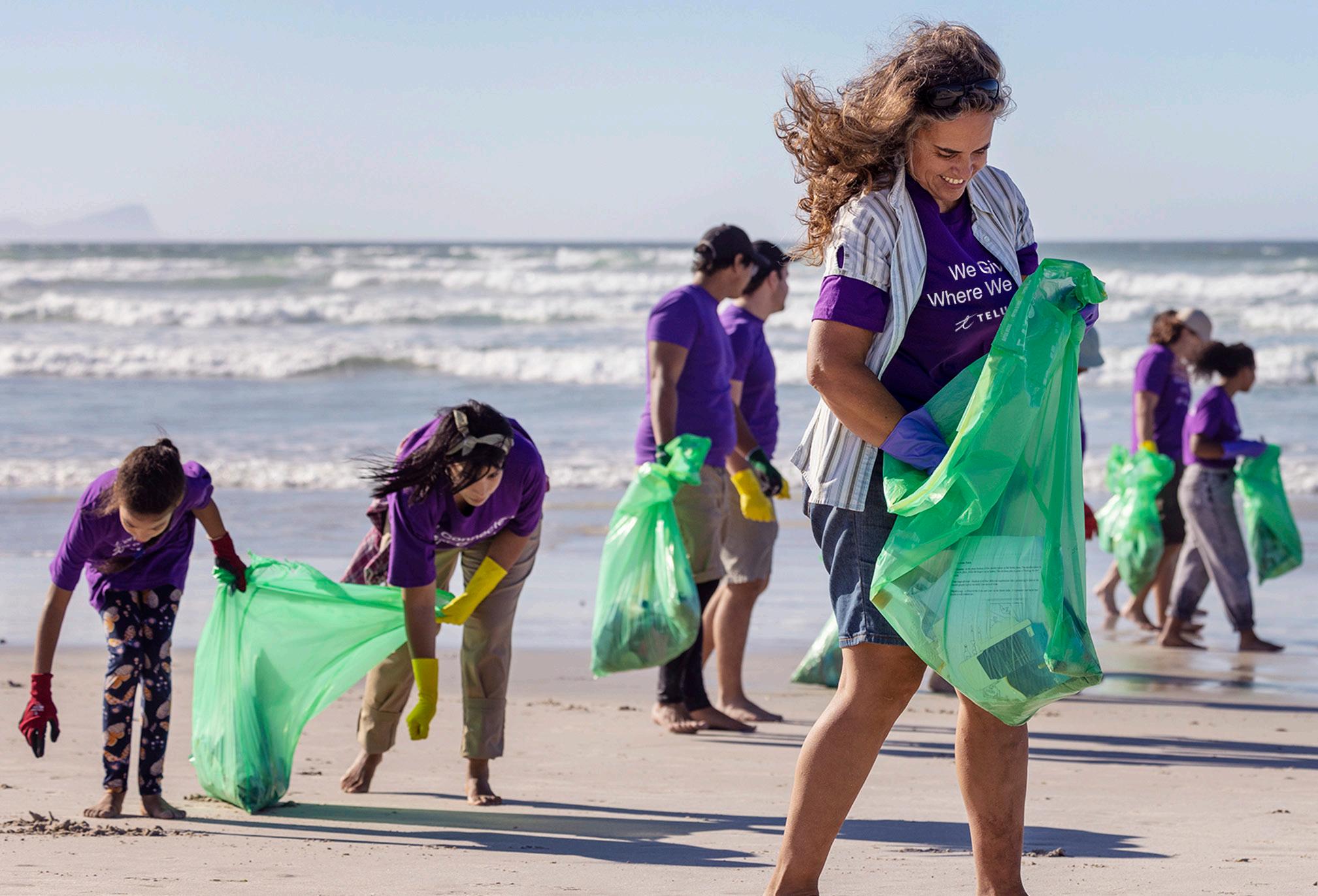
“Currently, we’re doing that in the green carbon space through tree planting, which has had an incredible response from both team members and customers. We’ve been planting trees for multiple initiatives – like on behalf of our team members when they hit a career milestone, or for team-building events. We’re even integrating tree planting into product campaigns
for customers.”
As part of its mission to become a zero-waste, carbon-neutral company by 2030, TELUS has just passed its goal of planting one million trees and continues to expand its tree planting to support the well-being of forests. The company recently expanded its tree planting efforts through the acquisition of Shakti, an environmentally driven reforestation company specializing in site preparation, seed collection, tree sourcing and tree planting.
“TELUS is also looking to innovate by leveraging some of our core competencies and bringing them to this new space to
“When you think about typical forests, oceans or remote areas, there often isn’t connectivity in those places. But if you bring in connectivity, you can have real-time data, closer monitoring capabilities and increased safety and engagement with stakeholders. There’s ample opportunity to find new ways to help protect and regrow our forests.”
Geoff Pegg, head of sustainability, says digitizing the forestry sector is part of the company’s ambition to decarbonize its operations, but also to offer solutions for customers and communities on how they can help decarbonize, particularly through the carbon capture that trees provide.
“We’re committed to helping our customers achieve their own environmental goals by building an end-to-end suite of innovative digital forestry solutions,” says Pegg. “We’re all in this together, and together is how we can make a real difference for future
68 CANADA’S GREENEST EMPLOYERS (202 3) PROVIDED CONTENT
TELUS employees participating in shoreline cleanup activities across Canada.
There’s ample opportunity to find new ways to help protect and regrow our forests.
— Rachel Mackay Manager, Business Development, Environment
generations to come.”
Pegg says tree planting has resonated so much with people, there has been a huge uptick in team members wanting to organize tree planting events as part of their volunteer time.

“We have a lot of passionate team members who want to make
our planet more sustainable,” says Pegg, who participated in a tree planting just south of Edmonton last August. “Around 30 of us went out to do a tree plant which included a learning session on how and why we plant trees.
“On that day we planted 1,000 spruce trees in a few hours,” he

says. “It was loads of fun and a memorable experience for everyone.”
Pegg is confident that TELUS will reach its carbon-reduction goals by 2030.

“Our team is determined,” he says. “We have lots of plans and programs in place to reduce our
environmental impacts, particularly greenhouse gas emissions, not only operationally but also in our value chain. In fact, we issued Canada’s first sustainability-linked bond in June 2021. We’re putting our money where our mouth is. Yes, we’re gonna make it!”
69 CANADA’S GREENEST EMPLOYERS (202 3) PROVIDED CONTENT
We’re hiring. Join our purpose-driven team. telus.com/careers
TELUS recently passed its goal of planting one million trees and continues to support the well-being of forests.
Committing to 100% renewable electricity by 2025 Becoming a zerowaste & net carbonneutral company by 2030
Enabling customers to trade in, repair or donate old devices Continuing leadership in sustainable finance
The Toronto Zoo conserves locally, thinks globally

market in the global food industry and in many personal care products. Gibson did an audit of ingredients in zoo gift-shop items such as cookies and body care products, sometimes tracking sources right back to the manufacturers, and found, “we were good – 100 per cent sustainable.”
Awhile back, Nia Gibson was walking on a wooded path in the Toronto Zoo, where she works, and spotted a skunk wrestling with a large coffee cup and its domed lid with a wide hole, which had stuck on its head. She managed to get the lid off – and avoid being sprayed – and reported the incident to zoo leadership and food services.
“After that, they stopped using
those lids,” she says. “They cared about this skunk, and it was great to see that if you notice something wrong, they will do something about it and make a change.”
Dealing with the ecological hazards of modern life is a big part of how the zoo approaches sustainability, in addition to its core mission of fighting extinction.
Gibson’s role is learning & engagement co-ordinator, arranging public and school programs to teach visitors about
what the zoo does, including a lot about biodiversity. But she is also part of the zoo’s Green Team, a voluntary staff group from every department that looks at various issues and works on solutions.

“My area is palm oil,” she says, “as the zoo has had a goal to be 100 per cent certified sustainable in palm oil by 2023.” Ecologists say that rainforest destruction and species extinction is being caused by ever-expanding palm plantations, which supply a ready
Similarly, the Green Team has worked on a used cellphone collection program called PhoneApes, to help recycle the key mineral elements in phones that have sparked a surge in mining in major animal habitats in Africa, says the team’s chair, Kyla Greenham, manager of conservation programs and environment. “We have them 100 per cent recycled here in Ontario, and the funds we receive from the recycling go to Africa for in-field conservation programs,” she says. “We have Western lowland gorillas at the zoo, so that’s where we make the connection to the public – the impact of electronics on animal habitat.”
There is also a program to
70 CANADA’S GREENEST EMPLOYERS (202 3) PROVIDED CONTENT
Toronto Zoo CEO, Dolf DeJong, planting trees for a program that aims to restore native biodiversity.
We believe that we have to be a leader in conservation and sustainability in order to protect wildlife and wild spaces.
— Kyla Greenham Manager of Conservation Programs and Environment
recycle items from staff and the public that municipal collections generally won’t take – from coffee capsules to bathroom products –and a staff-led initiative to plant more trees in open spaces at the zoo, an acre at a time. Recently, the zoo began installing a new ‘Plastics Pathway,’ running



through the displays and highlighting ways of dealing with plastics pollution. It is working with its vendors and suppliers to try to become plastic-free by 2027.
Overall, the zoo has some big net-zero goals. In 2022, it refreshed its sustainability platform, first established in 2007, and set targets



to reach net-zero waste output by 2027 and net-zero water usage and net-zero greenhouse gas emissions by 2030.

“We believe that we have to be a leader in conservation and sustainability in order to protect wildlife and wild spaces,” says Greenham. “And we think that


Igniting
because of our unique showcase opportunity, with the guests coming and visiting the different facilities, we have a great way to show how that can be done.”
Needless to say, too, the zoo is a world leader in the conservation of animals – including local skunks.

71 CANADA’S GREENEST EMPLOYERS (202 3) PROVIDED CONTENT
Connecting people, animals and conservation science to fight extinction. Open year-round!
A rooftop garden at the Toronto Zoo.
Your Toronto Zoo! Learn more about our conservation efforts at torontozoo.com
Passion at
Plastic-free campaign Zero-waste employee program to educate staff LEED employee program with training PhoneApes program to collect e-waste
Green transportation keeps TransLink energized
system HandyDART, as well as the SeaBus. The passenger ferry offers a 15-minute ride between downtown Vancouver and North Vancouver.
Colin Cuvelier, a certified commercial transport mechanic, has worked on three different incarnations of sustainable buses at Coast Mountain Bus Company, a subsidiary of TransLink (South Coast British Columbia Transportation Authority), since 2012.
“This is the future and TransLink is focused on making the electric bus work. I agree with them because it’s what we have to do,” Cuvelier says.
Patricia Lucy, director of brand
marketing and ridership development, explains that TransLink, established in 1999 and based in New Westminster, B.C. to serve Metro Vancouver, is a multimodal transportation authority that has sustainability in its DNA.
“The vision was around one single entity that oversees sustainable transportation across the region,” Lucy says, “It’s really about how we help people get around and how we get them around in a more sustainable way.”
The need is great, Lucy adds.
“We’re in a space where affordability, the environment and the climate are in huge crisis. So we all have a role to play in sustainability.”
TransLink is responsible for transit, walking and cycling infrastructure, but its mandate also includes the major road network as well as bridges, notes Lucy.
“So we really plan, fund and build the whole gamut of the transportation system,” she says. The TransLink network also includes SkyTrain rapid transit, its own transit police, the paratransit
“Climate should be top of mind for everyone. It means a lot to our TransLink employees and attracting new employees into the transportation industry,” Lucy adds. “They want to work for someone who cares about the same things they do.

“We are moving people away from the single-occupant vehicle and giving them more choice around sustainable travel, making it easier for them to walk, cycle or take transit,” says Lucy. “As we progress with our electric fleet and other measures it brings us towards meeting our net-zero GHG climate goals by 2050.”
Mechanic Cuvelier says he began working on the first green bus, the diesel hybrid, in 2012 although it’s been in service since 2009.
“Then I started working on the natural gas buses, so that was the
72 CANADA’S GREENEST EMPLOYERS (202 3) PROVIDED CONTENT
TransLink is expanding its battery-electric bus fleet which helps reduce over 1,000 tonnes of greenhouse gas emissions annually.
We’re in a space where affordability, the environment and the climate are in huge crisis. So we all have a role to play in sustainability.
— Patricia Lucy Director of Brand Marketing and Ridership Development
second greener bus. I call them that because natural gas is a greener fuel compared to diesel,” Cuvelier says. “That led me to the fully electric buses that go quite a distance without charging.


“I service every aspect of the vehicles, the big ones whether a 40- or 60-foot bus, natural gas
or electric.”
Fast charging is done through a basic pantograph system in which the bus has rails on top and the charging station has rails that descend to it.
“The two rails on the pantograph sit on top of the two bus rails and that puts on the

charge,” Cuvelier says.
Vancouver has also operated traditional electric trolley buses since 1948 and has the secondlargest fleet of this kind in North America.
Overall, TransLink moves about 380,000 people a day, down slightly from before the pandemic
but rising again. “We’re back about 80 per cent,” says Lucy.
“Our ridership recovery has been really strong in comparison to some of our sister agencies across North America. We’re having a great recovery because people rely on us,” Lucy adds.
“It’s why we exist.”
73 CANADA’S GREENEST EMPLOYERS (202 3) PROVIDED CONTENT
TransLink invests in traffic-protected bikeways to support cycling for people of all ages.
net-zero greenhouse gas (GHG) emissions by 2050
of total passenger kms travelled are on zeroemission modes
battery-electric bus saves 70 tonnes of GHGs annually Planning for a zeroemission fleet by 2040
Targeting
55%
Each
Vancouver lives up to its greenest city reputation
residents to live more sustainably, it has to walk the talk – not just reducing emissions in its more than 400 buildings and vehicles but also with its thousands of employees.
“If we want people to reduce their carbon emissions at home or in how they commute or move around Vancouver, it’s important we all play our part and show what’s feasible,” Telling says.
“When someone visits a library or community centre in Vancouver, we want them to see sustainable practices, and be inspired and encouraged by what we’re doing.”
Building on its admirable record of advancing sustainability through its decade-long ‘Greenest City Action Plan,’ the City of Vancouver amped up its commitment in 2020 when it created the ‘Climate Emergency Action Plan.’
Acknowledging that cities create more than 60 per cent of global emissions and are also sites for climate solutions and innovation, Vancouver has set bold targets to reduce its carbon pollution by 50 per cent by 2030.
Doing that means tackling emissions in buildings and
transportation, which is where most of its carbon pollution originates. It means using land-use planning tools, future-proofing infrastructure, and protecting and enhancing natural systems, which benefits health and safety, creates connected communities and strengthens Vancouver’s economy. Moving away from burning natural gas toward electrification in buildings is a big focus. So is encouraging active transportation in a Canadian city blessed with moderate weather, along with improved transit and adding infrastructure to support the
switch to electric vehicles.
“It’s about walkable, complete communities,” says Rachel Telling, a senior sustainability specialist. “Wherever you live in Vancouver, it should be safe and convenient to walk, bike or roll to amenities and whatever you need.”
Every time a City-owned or operated building comes up for renewal, deep emissions reductions and innovative solutions are prioritized. In a recent community centre retrofit, for example, hot water from the new highly efficient electric heat pump system powers the Zamboni.
The City knows that to inspire
— Rachel Telling Senior Sustainability Specialist
In fact, the intent behind the City’s internal sustainability plan – its Green Operations Plan – is that the City, as an employer, will match or exceed any target set for the community. “We’ll use that to test new initiatives before we expect the community to do the same,” says Telling.
The City’s sustainable commuting program encourages employees to take transit, walk, cycle or roll to work. That includes rebates on transit passes; a reward-based system for biking and walking; employee discounts on bike shares; as well as showers, lockers and secure bike parking at all offices.
Transportation engineer Angie

74 CANADA’S GREENEST EMPLOYERS (202 3) PROVIDED CONTENT
The City of Vancouver encourages employees to commute sustainably by providing employee discounts on bike shares.
Sustainability is really integrated through all departments.
Rewards and incentives for employees who commute sustainably
Organization-wide zero waste program
Zero carbon plan for fleet vehicles and building emissions
Sustainable and ethical purchasing policy for all procurement activities
Weddell leads the City’s Bike to Work Week team, with events, prizes and internal competitions that take place to promote cycling. There are also daily challenges and organized group rides at lunchtime and after work. “We just try to get everybody together and excited about cycling,”
she says.
Among many initiatives, Vancouver is electrifying its vehicle fleet and diverting over 90 per cent of waste from corporate sites. Its printer program cuts down on wasted paper, it only purchases from companies that follow certain sustainability

criteria, it has banned single-use plastics, and it uses only Green Seal certified cleaning products. Staff have access to sustainability courses, and an internal fund is set aside to help employees act on opportunities they see to reduce the burden on the climate.
“Sustainability is really integrated
through all departments,” says Telling.
“A lot of cities look to us for what we’re doing and we look to others for best practice and leadership,” she adds. “So if we don’t remain ambitious in our climate actions, there’s a risk that other cities won’t either.”

75 CANADA’S GREENEST EMPLOYERS (202 3) PROVIDED CONTENT
Animal services employees at the City of Vancouver.

Tell us your story If you are an exceptional employer with progressive human resources programs and initiatives, consider applying for next year’s edition of Canada’s Greenest Employers. Now entering its 24th year, our national project is Canada’s longest-running and best-known editorial competition for employers. For information on next year’s application process, visit: CanadasTop100.com/2024 Applications for our 2024 competition will be released in February and must be returned by May.














































































































































